Rethinking Climate, Climate Change, and Their Relationship with Water
Abstract
There’s no such thing as bad climate, only bad clothesParaphrasis of a Scandinavian proverb
Each definition is a piece of secret ripped from Nature by the human spirit.Nikolai Luzin (from [1])
1. Introduction
2. History of the Notion of Climate
By climate we mean the average weather as ascertained by many years’ observations. Climate also takes into account the extreme weather experienced during that period. Climate is what on an average we may expect, weather is what we actually get.
Climate is the sum total of the weather experienced at a place in the course of the year and over the years. It comprises not only those conditions that can obviously be described as ‘near average’ or ‘normal’ but also the extremes and all the variations.
3. Modern Definitions of Climate
- (1)
- By the USA National Weather Service [14]:
Climate–The composite or generally prevailing weather conditions of a region, throughout the year, averaged over a series of years.
- (2)
- By the Climate Prediction Center of the National Weather Service [15]; notice that the Center refers to Herbertson’s quotation as if it were an old saying:
Climate–The average of weather over at least a 30-year period. Note that the climate taken over different periods of time (30 years, 1000 years) may be different. The old saying is climate is what we expect and weather is what we get.
- (3)
- By the American Meteorological Society [16]:
Climate–The slowly varying aspects of the atmosphere–hydrosphere–land surface system. It is typically characterized in terms of suitable averages of the climate system over periods of a month or more, taking into consideration the variability in time of these averaged quantities. Climatic classifications include the spatial variation of these time-averaged variables. Beginning with the view of local climate as little more than the annual course of long-term averages of surface temperature and precipitation, the concept of climate has broadened and evolved in recent decades in response to the increased understanding of the underlying processes that determine climate and its variability.
The system, consisting of the atmosphere, hydrosphere, lithosphere, and biosphere, determining the earth’s climate as the result of mutual interactions and responses to external influences (forcing). Physical, chemical, and biological processes are involved in the interactions among the components of the climate system.
- (4)
- By the World Meteorological Organization (WMO) [21]:
C0850 climate–Synthesis of weather conditions in a given area, characterized by long-term statistics (mean values, variances, probabilities of extreme values, etc.) of the meteorological elements in that area.
C0900 climate system–System consisting of the atmosphere, the hydrosphere (comprising the liquid water distributed on and beneath the Earth’s surface, as well as the cryosphere, i.e., the snow and ice on and beneath the surface), the surface lithosphere (comprising the rock, soil and sediment of the Earth’s surface), and the biosphere (comprising Earth’s plant and animal life and man), which, under the effects of the solar radiation received by the Earth, determines the climate of the Earth. Although climate essentially relates to the varying states of the atmosphere only, the other parts of the climate system also have a significant role in forming climate, through their interactions with the atmosphere.
- (5)
- By the Intergovernmental Panel on Climate Change (IPCC) [22]:
the view, regarded as scientific, which was widely taught in the earlier part of this century, that climate was essentially constant apart from random fluctuations from year to year was at variance with the attitudes and experience of most earlier generations. It has also had to be abandoned in face of the significant changes in many parts of the world that occurred between 1900 and 1950 and other changes since.
W0410 weather–State of the atmosphere at a particular time, as defined by the various meteorological elements.
4. Toward a Rigorous Definition of Climate
5. Climate and Water
- Abundance. The water in the oceans amounts to 1.34 × 109 Gt [61] while additional quantities are stored in the soil, ground and glaciers (which generally are not in turbulent motion, see below) and much smaller quantities of liquid water are on land. For comparison the mass of air in the atmosphere is 5.14 × 106 Gt (of which 12,500 Gt is water vapour) [62], i.e., 260 times smaller than the mass of water in turbulent motion.
- Heat storage. Water’s specific heat (or heat capacity) is 4218 and 2106 J kg−1 K−1 for the liquid and solid phase, respectively, and 1463 and 1924 J kg−1 K−1 for the gaseous phase for constant volume and constant pressure, respectively [63]. These figures are considerably larger than the specific heat of dry air (707 and 1004 J kg−1 K−1 for the gaseous phase for constant volume and constant pressure, respectively), as well as of the dry soil (typically 800 J kg−1 K−1). As a result of its high heat capacity and abundance, water is the element that determines the heat storage and hence the climate of the Earth. For example, in the last forty years, accumulated heat in the oceans is 94% of the total, with the remaining 6% distributed to ice, land and atmosphere (see details in Appendix D). For the same reason, water has been called the climatic thermostat of the Earth [64].
- Heat exchange. For the average temperature of Earth, the specific latent heat of water evaporation (calculated from “Equation (40)” in [65]) is 2.47 MJ/kg, much higher than in other common substances. Also, the specific latent heat of ice melt (solid water fusion) is 0.334 MJ/kg, again higher than in other common substances. Combined with the fact that water abounds on Earth in all three phases, these high values of phase change energy make water the thermodynamic regulator of climate. In particular, heat exchange by evaporation (and hence the latent heat transfer from the Earth’s surface to the atmosphere) is the Earth’s natural locomotive, with the total energy involved in the hydrological cycle being 1290 ZJ/year, corresponding to an energy flux density of 80 W/m2 [59]. Compared to human energy production (0.612 ZJ/year for 2014), the total energy of the natural locomotive is 2100 times higher than that of the human locomotive [59].
- Shortwave radiation regulation. An interesting property of water is the spectacular differences, among the different phases and formations, in the reflecting properties of the incoming sunlight, that is, the albedo. Thus, the albedo of liquid water is only 5% near the equator (but increases up to 76% near the poles for winter months [66]), while for ice it is 32–38%, and increases further to 45% for old snow and up to 85% for fresh snow. Even though water vapour is transparent to shortwave radiation, the water has a huge effect on the radiation properties of the atmosphere through the clouds. The albedo of clouds varies by even larger ranges, from 10% to more than 80% [67], depending on drop sizes, liquid water or ice content, thickness of the cloud, and sunray’s angle. The importance of the albedo can be understood by this example: The incoming solar radiation is 341 W/m2 [68]; this is the solar constant divided by four, in order to take the average over the entire Earth’s surface of the amount of sunlight power that reaches the atmosphere. Given that, a tiny change of 1‰ in the albedo due to differences in the presence of water formations (snow, ice, clouds) results in an “imbalance” of 0.34 W/m2. This is of the same order or magnitude of the average imbalance (net absorbed energy) of the Earth in the last 50 years, allegedly attributed to the increase of the CO2 concentration (see calculations in Appendix D). We note that the 10-year climatic variability of albedo in the last 40 years was 1% (see calculations in Appendix E), i.e., 10 times higher than in our hypothetical change of 1‰ of our example.
- Longwave radiation regulation. Even though in the common perception it is carbon dioxide (CO2) that determines the greenhouse effect of the Earth, recent studies (Schmidt et al. [69]) attribute only 19% of the longwave radiation absorption to CO2 against 75% of water vapour and clouds, or a ratio of 1:4. According to other estimations, the importance of CO2; as a greenhouse gas is even lower and that of water higher [60]. Another misconception, common in nonexperts, is that atmospheric CO2; is the product of human emissions, while in fact the latter contribute only 3.8% to the global carbon cycle [48]. Water, as a universal solvent, plays some role for the presence of CO2 in the hydrosphere and the atmosphere. This role is described by Henry’s law [70], according to which increase of water temperature results in decreasing solubility of CO2 in water and hence CO2 degassing from the ocean. To this physical process we should add the fact that increase of temperature (T) results in increased respiration of the biosphere on land and sea. Based on such considerations, and using reliable instrumental measurements of global T and CO2 concentration covering the time interval 1980–2019, a recent study [49] found that in the relationship of CO2 and temperature, the dominant causality direction is T → CO2, rather than the other way round, despite the latter being the common perception.
- Turbulent motion. The climate is generated by the everlasting turbulent motion of two fluids, water and air. The turbulent dynamics in the circulation of both fluids is much more complex and less well known than thermodynamics [71]. The motion of both fluids is thus inherently uncertain and produces patterns that can hardly be predicted in advance. In the atmosphere, the complexity in motion is further perplexed due to the presence of water in the air, in the form of vapour and clouds, which play a crucial role. For example, recent studies [72,73] point to the role of water vapour and clouds in warming the Arctic environment. Because humans (as contrasted to fish) live in contact with the atmosphere, the motion in the atmosphere is better observed and studied than in the hydrosphere. This does not mean that the motion in the latter, particularly the large-scale fluctuations, is less important for climate. For example, the rhythm of coupled ocean–atmosphere fluctuations, such as the El Niño–Southern Oscillation (ENSO), Atlantic Multidecadal Oscillation (AMO) and Interdecadal Pacific Oscillation (IPO), significantly influences the variability of global mean annual temperature [74].
- Elixir of life. The phrase “water is the elixir of life” appeared in the 19th century in a book by Allen [75], who attributes it to “Scriptures” and asserts that three fourths of diseases are caused by abuse of water. More recently, Eagleson [76] used the same phrase justifying it by the fact that water is a universal solvent and that cell membranes are permeable only to dissolved substances. Thus, the biosphere depends on water, whose presence determines the type and extent of ecosystems. In turn, the ecosystems affect climate at large through the carbon and oxygen cycles (where the vast majority of the CO2; and O2; emissions are products of life, through respiration and photosynthesis, respectively), and their contribution in the water cycle (transpiration) and in the energy cycle (photosynthesis). Humans, as part of the biosphere, also interact with water and climate; they are affected by them and affect them. Since the invention of technology in the Neolithic age and, in particular, the establishment of perennial agriculture and the advent of urbanization, these human effects became larger in terms of land-use change and contribution in the mass and energy cycles. Moreover, after the industrial revolution, the anthropogenic effects are marked and in certain aspects unsustainable. Notably, human interventions on land and on water bodies may have much more substantial effects on the entire Earth than the infamous fossil fuel burning and the resulting CO2; emissions. For example, considering sea level rise, the most prominent anthropogenic signal is the increased (and unsustainable) exploitation of groundwater, which transfers to the sea huge masses of water earlier stored in the land [59]. To describe the growing impacts of human activities on Earth, including in geology and ecology, P. Crutzen and E. Stoermer proposed the term anthropocene for the current geological epoch [77]. However, the proposal has not been ratified by the International Commission on Stratigraphy, nor by the International Union of Geological Sciences (note that neither of the proposers was a geologist; Crutzen was an atmospheric chemist and Stoermer a biologist). Nonetheless, the term is quite popular in other disciplines in an environmental, bioethical and political context [78], with the latter sometimes related to “urging to action”. The term was criticised by M. Sagoff [79], who asserted that the underlying idea that humans rule Nature “accomplishes a counter-Copernican revolution”, in which “The Anthropocene makes humanity great again”, hence implying that the term is equivalent to “Narcisscene” (which he uses in his article title).
6. The Term “Climate Change”
Climate change refers to a change in the state of the climate that can be identified (e.g., by using statistical tests) by changes in the mean and/or the variability of its properties, and that persists for an extended period, typically decades or longer. Climate change may be due to natural internal processes or external forcings such as modulations of the solar cycles, volcanic eruptions and persistent anthropogenic changes in the composition of the atmosphere or in land use.
Note that the Framework Convention on Climate Change (UNFCCC), in its Article 1, defines climate change as: ‘a change of climate which is attributed directly or indirectly to human activity that alters the composition of the global atmosphere and which is in addition to natural climate variability observed over comparable time periods’. The UNFCCC thus makes a distinction between climate change attributable to human activities altering the atmospheric composition, and climate variability attributable to natural causes.
the drought and subsequent famine in the Sahelian zone if North Africa during the late 1960s and early 1970s has focused world attention on the implication of climate change. According to evidence gathered by climatologists, the Northern Hemisphere has been cooling since the mid-1940s.
man-made disasters, have been threatened by a natural one: the possibility of climatic changes in the monsoon belt and perhaps throughout the world. The implications for global food and population policies are ominous. The United States proposes that the International Council of Scientific Unions and the World Meteorological Organization; urgently investigate this problem and offer guidelines for immediate international action.
Climate Change, Food Production, and Interstate Conflict. This interdisciplinary conference, organized jointly by RF officers from Conflict in International Relations, Quality of the Environment, and Conquest of Hunger programs, will bring together climatologists, scientists concerned with food production and others with experience with national public policy, and foundation representatives to examine the future implications of the global cooling trend now under way and its effects on world food production. Countries to be represented include the United States, Canada, the United Kingdom, and India.
Several science editors were asked to participate in Foundation meetings on climate change, food production and interstate conflict, genetic resistance in plants to pests, and aquaculture. Stories appeared subsequently on the front page of The New York Times, and the Associated Press carried substantial stories which were widely used. In each instance, the writers were introduced to our program officers and encouraged to use them as resource people. (Officers are now, in fact, being called on by journalists, particularly in areas of current high news interest such as food production, population problems, environmental issues, and the arts.)
led to the publication in 1976 of a report called Climatic Change, Food Production and Interstate Conflict, which reached the desk of Henry Kissinger, then the U.S. Secretary of State.
- In 1974, an article entitled “Another Ice Age?” [98] stated:
when meteorologists take an average of temperatures around the globe they find that the atmosphere has been growing gradually cooler for the past three decades. The trend shows no indication of reversing.
- In 1976, an article entitled “Environment: The World’s Climate: Unpredictable” [99] gave two possibilities for the future climate. It is interesting to note that both are catastrophic and, while the two are opposite to each other, the intermediate case is not regarded a possibility at all:
Climatologists still disagree on whether earth’s long-range outlook is another ice age, which could bring mass starvation and fuel shortages, or a warming trend, which could melt the polar icecaps and flood coastal cities.
- In 1987, the front cover of the issue of 19 October announced “The Heat is On” and an article with the same title [100], mostly devoted to the depletion of ozone, also asserted:
Potentially more damaging than ozone depletion, and far harder to control, is the greenhouse effect, caused in large part by carbon dioxide (CO2). The effect of CO2 in the atmosphere is comparable to the glass of a greenhouse: it lets the warming rays of the sun in but keeps excess heat from reradiating back into space. Indeed, man-made contributions to the greenhouse effect, mainly CO2 that is generated by the burning of fossil fuels, may be hastening a global warming trend that could raise average temperatures between 2 degrees F and 8 degrees F by the year 2050.
What would happen if nothing were done about the earth’s imperiled state? According to computer projections, the accumulation of CO2 in the atmosphere could drive up the planet’s average temperature 3 degrees F to 9 degrees F by the middle of the next century. That could cause the oceans to rise by several feet, flooding coastal areas and ruining huge tracts of farmland through salinization. Changing weather patterns could make huge areas infertile or uninhabitable, touching off refugee movements unprecedented in history.
- In 1992, the salvation of the Earth began, as announced in the front-cover of Time’s issue of 1 June: “Coming Together to Save the Earth” [102].
7. Discussion
The many ingenious formulations of theory of climate in terms of global mathematical models are likely to prove fallacious in one or another way unless and until equal attention is paid to establishing the past record of climatic behaviour and assimilating the lessons from it.
We know that climate has undergone many changes in the past and that it will continue to change in the future. In other words, the climate is always evolving and it must be regarded as a living entity. Thus we should avoid the misleading concept of the constant nature of climate.
8. Conclusions
Funding
Institutional Review Board Statement
Informed Consent Statement
Data Availability Statement
Acknowledgments
Conflicts of Interest
Appendix A. Ancient and Early Modern Quotations about Climate
Aἰγύπτιοι ἅμα τῷ οὐρανῷ τῷ κατὰ σφέας ἐόντι ἑτεροίῳ καὶ τῷ ποταμῷ φύσιν ἀλλοίην παρεχομένῳ ἢ οἱ ἄλλοι ποταμοί, τὰ πολλὰ πάντα ἔμπαλιν τοῖσι ἄλλοισι ἀνθρώποισι ἐστήσαντο ἤθεά τε καὶ νόμους.
(The Egyptians in agreement with their climate, which is unlike any other, and with the river, which shows a nature different from all other rivers, established for themselves manners and customs in a way opposite to other men in almost all matters–English translation by G.C. Macaulay, 1890).
δυσχείμερος δὲ αὕτη ἡ καταλεχθεῖσα πᾶσα χώρη [Σκυθία] οὕτω δή τι ἐστί, ἔνθα τοὺς μὲν ὀκτὼ τῶν μηνῶν ἀφόρητος οἷος γίνεται κρυμός, ἐν τοῖσι ὕδωρ ἐκχέας πηλὸν οὐ ποιήσεις, πῦρ δὲ ἀνακαίων ποιήσεις πηλόν: ἡ δὲ θάλασσα πήγνυται καὶ ὁ Βόσπορος πᾶς ὁ Κιμμέριος, καὶ ἐπὶ τοῦ κρυστάλλου οἱ ἐντὸς τάφρου Σκύθαι κατοικημένοι στρατεύονται καὶ τὰς ἁμάξας ἐπελαύνουσι πέρην ἐς τοὺς Σίνδους. οὕτω μὲν δὴ τοὺς ὀκτὼ μῆνας διατελέει χειμὼν ἐών, τοὺς δ᾽ ἐπιλοίπους τέσσερας ψύχεα αὐτόθι ἐστί. κεχώρισται δὲ οὗτος ὁ χειμὼν τοὺς τρόπους πᾶσι τοῖσι ἐν ἄλλοισι χωρίοισι γινομένοισι χειμῶσι, ἐν τῷ τὴν μὲν ὡραίην οὐκ ὕει λόγου ἄξιον οὐδέν, τὸ δὲ θέρος ὕων οὐκ ἀνιεῖ: βρονταί τε ἦμος τῇ ἄλλῃ γίνονται, τηνικαῦτα μὲν οὐ γίνονται, θέρεος δὲ ἀμφιλαφέες: ἢν δὲ χειμῶνος βροντὴ γένηται, ὡς τέρας νενόμισται θωμάζεσθαι. ὣς δὲ καὶ ἢν σεισμὸς γένηται ἤν τε θέρεος ἤν τε χειμῶνος ἐν τῇ Σκυθικῇ, τέρας νενόμισται. ἵπποι δὲ ἀνεχόμενοι φέρουσι τὸν χειμῶνα τοῦτον, ἡμίονοι δὲ οὐδὲ ὄνοι οὐκ ἀνέχονται ἀρχήν: τῇ δὲ ἄλλῃ ἵπποι μὲν ἐν κρυμῷ ἑστεῶτες ἀποσφακελίζουσι, ὄνοι δὲ καὶ ἡμίονοι ἀνέχονται.
(This whole land [Scythia] which has been described is so exceedingly severe in climate, that for eight months of the year there is frost so hard as to be intolerable; and during these if you pour out water you will not be able to make mud, but only if you kindle a fire can you make it; and the sea is frozen and the whole of the Kimmerian Bosporus, so that the Scythians who are settled within the trench make expeditions and drive their waggons over into the country of the Sindians. Thus it continues to be winter for eight months, and even for the remaining four it is cold in those parts. This winter is distinguished in its character from all the winters which come in other parts of the world; for in it there is no rain to speak of at the usual season for rain, whereas in summer it rains continually; and thunder does not come at the time when it comes in other countries, but is very frequent, in the summer; and if thunder comes in winter, it is marvelled at as a prodigy: just so, if an earthquake happens, whether in summer or in winter, it is accounted a prodigy in Scythia. Horses are able to endure this winter, but neither mules nor asses can endure it at all, whereas in other countries horses if they stand in frost lose their limbs by mortification, while asses and mules endure it–ibid.)
ὅ τε γὰρ λόγος δείκνυσιν ὅτι ἐπὶ πλάτος μὲν [τὴν οἰκουμένην] ὥρισται, τὸ δὲ κύκλῳ συνάπτειν ἐνδέχεται διὰ τὴν κρᾶσιν, -οὐ γὰρ ὑπερβάλλει τὰ καύματα καὶ τὸ ψῦχος κατὰ μῆκος, ἀλλ’ ἐπὶ πλάτος, ὥστ’ εἰ μή που κωλύει θαλάττης πλῆθος, ἅπαν εἶναι πορεύσιμον, —καὶ κατὰ τὰ φαινόμενα περί τε τοὺς πλοῦς καὶ τὰς πορείας·
(theoretical calculation shows that [inhabited Earth] is limited in breadth, but could as far as climate is concerned, extend round the Earth in a continuous belt; for it is not difference of longitude but of latitude that brings great variation of temperature, and if were not for the ocean which prevent it, the complete circuit could be made. And the facts known to us from journeys by sea and land also confirm the conclusion;—English translation by H.D.P. Lee, Harvard University Press, Cambridge, Mass. USA, 1952).
πάντες, ὅσοι τόπων ἰδιότητας λέγειν ἐπιχειροῦσιν, οἰκείως προσάπτονται καὶ τῶν οὐρανίων καὶ γεωμετρίας, σχήματα καὶ μεγέθη καὶ ἀποστήματα καὶ κλίματα δηλοῦντες καὶ θάλπη καὶ ψύχη καὶ ἁπλῶς τὴν τοῦ περιέχοντος φύσιν.
(Everyone who undertakes to give an accurate description of a place, should be particular to add its astronomical and geometrical relations, explaining carefully its extent, distance, degrees of latitude, and ‘climate’—the heat, cold, and temperature of the atmosphere.—English translation by H.C. Hamilton, and W. Falconer, M.A., 1903)
αὕτη δὲ τῷ εἰς τὰς [πέντε] ζώνας μερισμῷ λαμβάνει τὴν οἰκείαν διάκρισιν: αἵ τε γὰρ κατεψυγμέναι δύο τὴν ἔλλειψιν τοῦ θάλπους ὑπαγορεύουσιν εἰς μίαν τοῦ περιέχοντος φύσιν συναγόμεναι, αἵ τε εὔκρατοι παραπλησίως εἰς μίαν τὴν μεσότητα ἄγονται, εἰς δὲ τὴν λοιπὴν ἡ λοιπὴ μία καὶ διακεκαυμένη.
(In the division into [five] zones, each of these is correctly distinguished. The two frigid zones indicate the want of heat, being alike in the temperature of their atmosphere; the temperate zones possess a moderate heat, and the remaining, or torrid zone, is remarkable for its excess of heat.—English translation by H.C. Hamilton, and W. Falconer, M.A., 1903).
Climate, From the Greek word Clima. of the same signification; it is a portion of the Earth or Heaven contained between two Parallels. And for distinction of Places, and different temperature of the Air, according to their situation; the whole Globe of Earth is divided into 24 Northern, and 24 Southern Climates, according to the half-hourly encreasing of the longest days; for under the Equator we call the first Climate: from thence as far as the Latitude extends, under which the longest day is half an hour more than under the Equator, viz. 12 h and an half, is the second Climate: where it is encreased a whole hour, the third Climate: and so each Northerly and Southerly Climate respectively hath its longest day half an hour longer than the former Climate, till in the last Climate North and South, the Sun Sets not for half a year together, but moves Circularly above the Horizon.
Appendix B. Definitions of Climate in Modern Books
Climate may be defined simply as an expression of meteorological phenomena representing weather occurring over a long period of time. It includes processes of exchange of energy and mass between the earth and the atmosphere. […] The aggregate of climatic conditions expressed as means, variance and extremes for a region over a period of many years is referred to as the macroclimate. The data used to describe the macroclimate are often based either upon 30 or more years of observation from a single station or upon the average of several measurements from stations at diverse locations within a particular region.
Description of the climate consisted primarily of estimates of its mean state and estimates of its variability about that state, such as its standard deviations and other simple measures of variability. […] The main purpose of this description is to define ‘normals’ and ‘normal deviations,’ which are eventually displayed as maps.
Climate is the synthesis of atmospheric conditions characteristic of a particular place in the long term. It is expressed by means of averages of the various elements of weather, and also the probabilities of other conditions, including extreme events.
We will regard the climate in a very broad sense in terms of the mean physical state of the climatic system. The climate can then be defined as a set of averaged quantities completed with higher moment statistics (such as variances, covariances, correlations, etc.) that characterize the structure and behavior of the atmosphere, hydrosphere, and cryosphere over a period of time. This definition of climate includes the more narrow traditional concept of climate based on the mean atmospheric conditions at the earth’s surface.
the long term statistical properties of the atmosphere […] constitute climate (for example, mean values and range of variability of various measurable quantities, such as temperature, and the frequencies of various events, such as rain or high winds, as a function of geographical location, season and time of day).
The word climate refers to the state of the atmosphere on longer time scales, typically averaged over several years or more. The understanding of climate and climate change does not necessarily require a complete understanding of every weather event; conversely there are physical processes, operating on long time scales, that are unimportant for weather prediction but crucial for climate prediction. (An example is heat transport from deep ocean which may vary on decadal or longer time scales.)
If we measure and observe these weather elements over a specified interval of time, say, for many years, we would obtain the “average weather” or the climate of a particular region. Climate, therefore, represents the accumulation of daily and seasonal weather events (the average range of weather) over a long period of time. The concept of climate is much more than this, for it also includes the extremes of weather—the heat waves of summer and the cold spells of winter—that occur in a particular region. The frequency of these extremes is what helps us distinguish among climates that have similar averages.
Appendix C. Examples of Climatic Evolution for Maximum and Minimum Daily Temperature
- for maximum daily temperature: Vienna (Wien, Austria; 48.23° N, 16.35° E, 199.0 m; GHCN-D station code: AU000005901; WMO station: 11035), covering the period 1855–2020 (167 years of data), and
- for minimum daily temperature: Melbourne (Melbourne Regional Office, Australia; 37.81° N, 144.97° E, 31.0 m; GHCN-D station code: ASN00086071; WMO station: 94868), covering the period 1855–2014 (160 years of data).
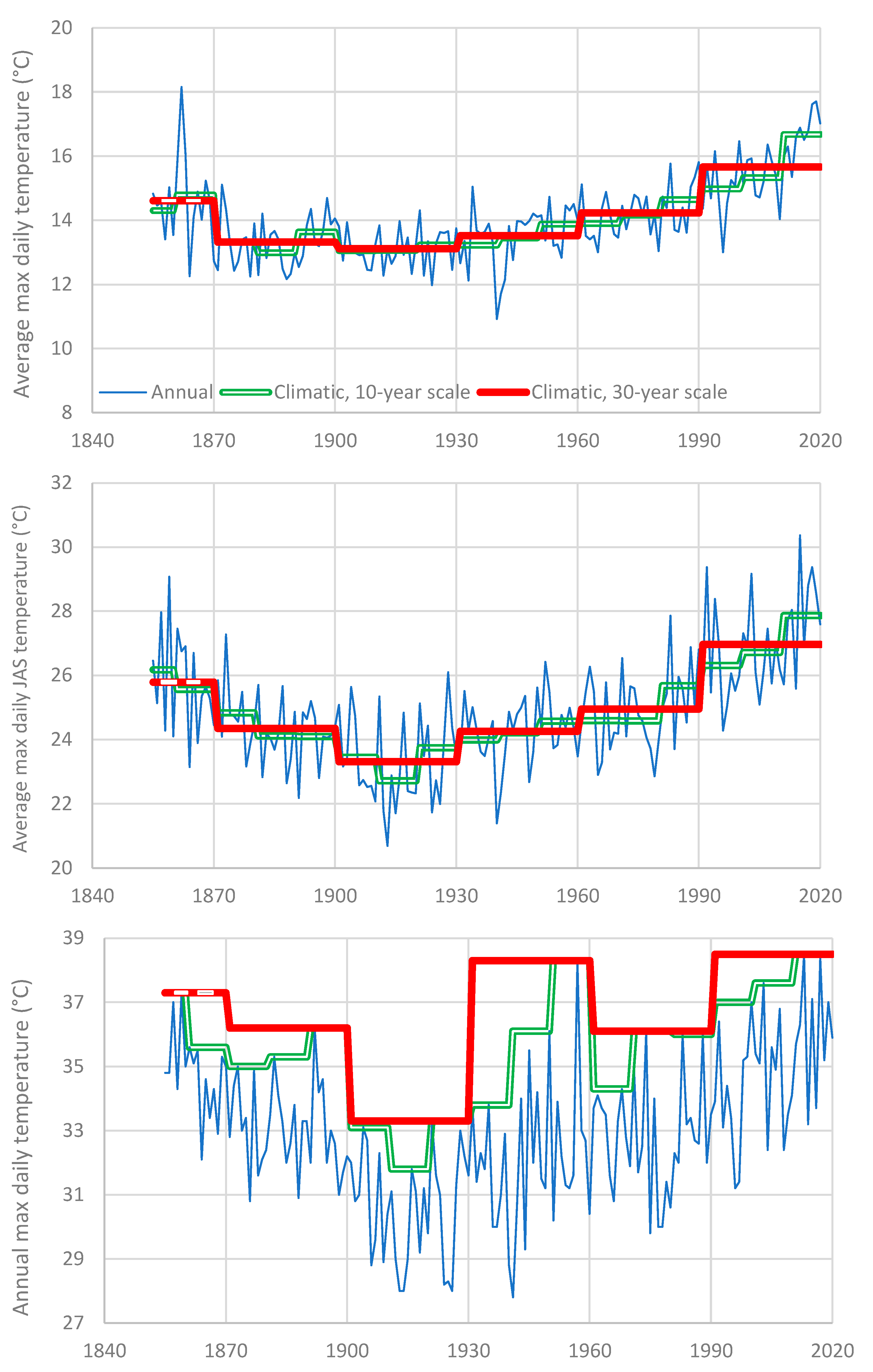
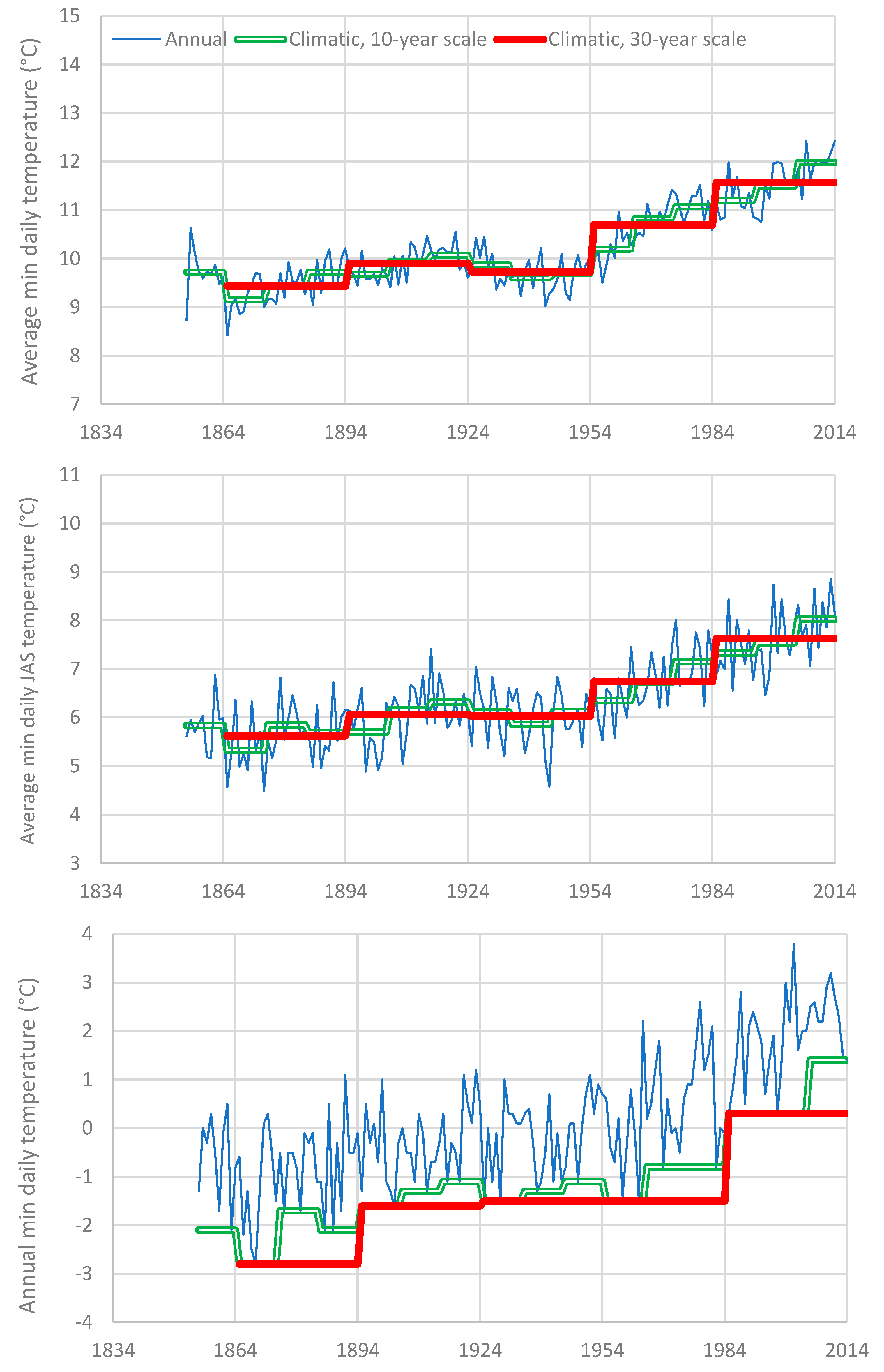
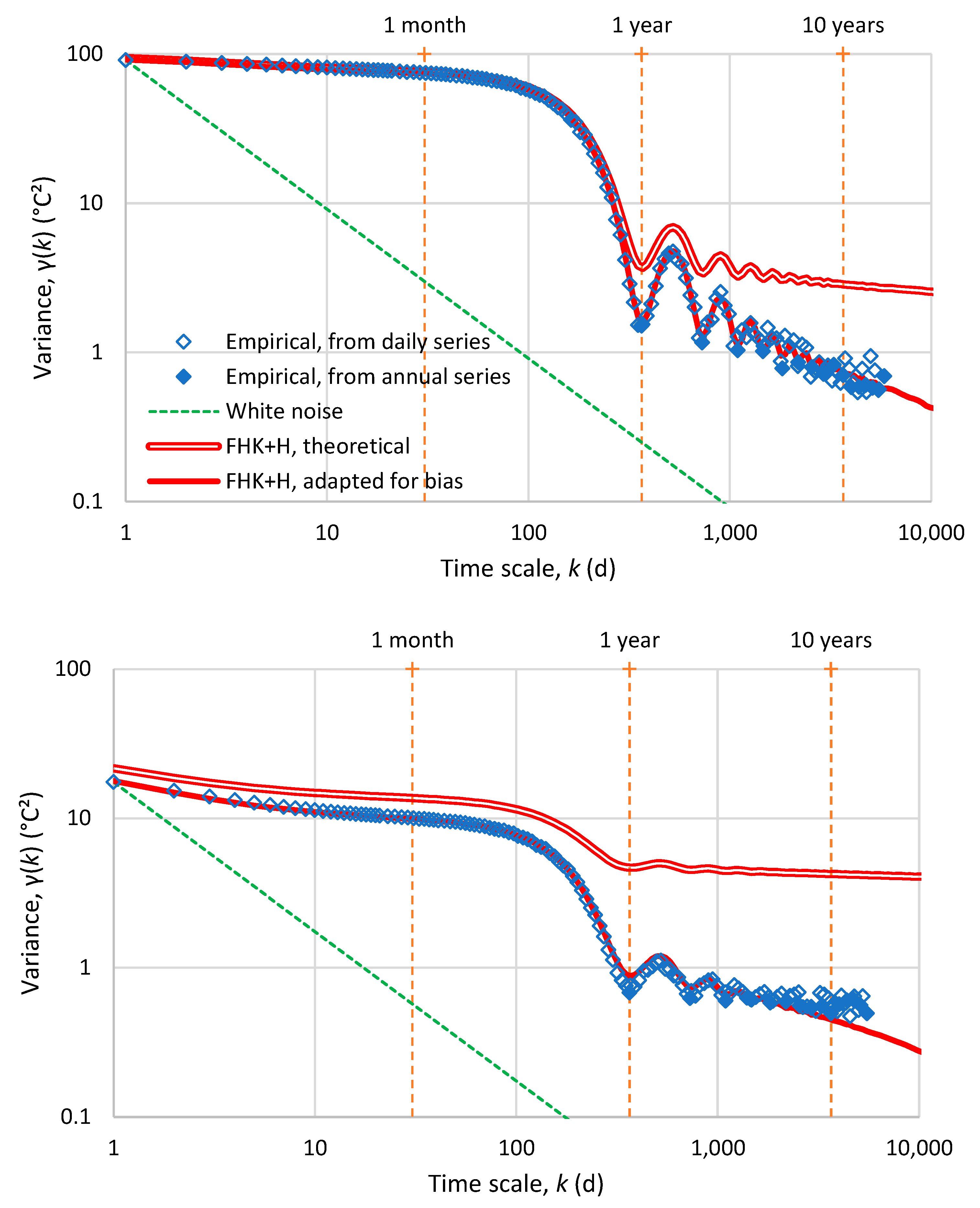
Appendix D. Rough Calculation of Earth’s Energy Imbalance
Currently there is an energy imbalance in the Earth’s climate system of almost 1 W m−2 […] Over 90% of this excess heat is absorbed by the oceans, leading to an increase of ocean heat content (OHC) and sea level rise, mainly through thermal expansion and melting of ice over land.
The new results indicate a total full-depth ocean warming of 380 ± 81 ZJ (equal to a net heating of 0.39 ± 0.08 W m−2 over the global surface) from 1960 to 2020, with contributions of 40.3%, 21.6%, 29.2% and 8.9% from the 0–300-m, 300–700-m, 700–2000-m, and below-2000-m layers, respectively.
Appendix E. Earth’s Albedo Changes
- TOA incoming shortwave flux (M2TMNXRAD.5.12.4, W/m2);
- TOA net downward shortwave flux, which is the difference between incoming and outgoing shortwave radiation from the Earth’s surface (M2TMNXINT.5.12.4, W/m2);
- Cloud albedo as provided by NASA’s MERRA-2 International Satellite Cloud Climatology Project (ISCCP) (from the COSP Satellite Simulator, M2TMNXCSP.5.12.4);
- ISCCP total cloud area fraction, estimated as the number of cloudy pixels divided by the total number of pixels (M2TMNXCSP.5.12.4).
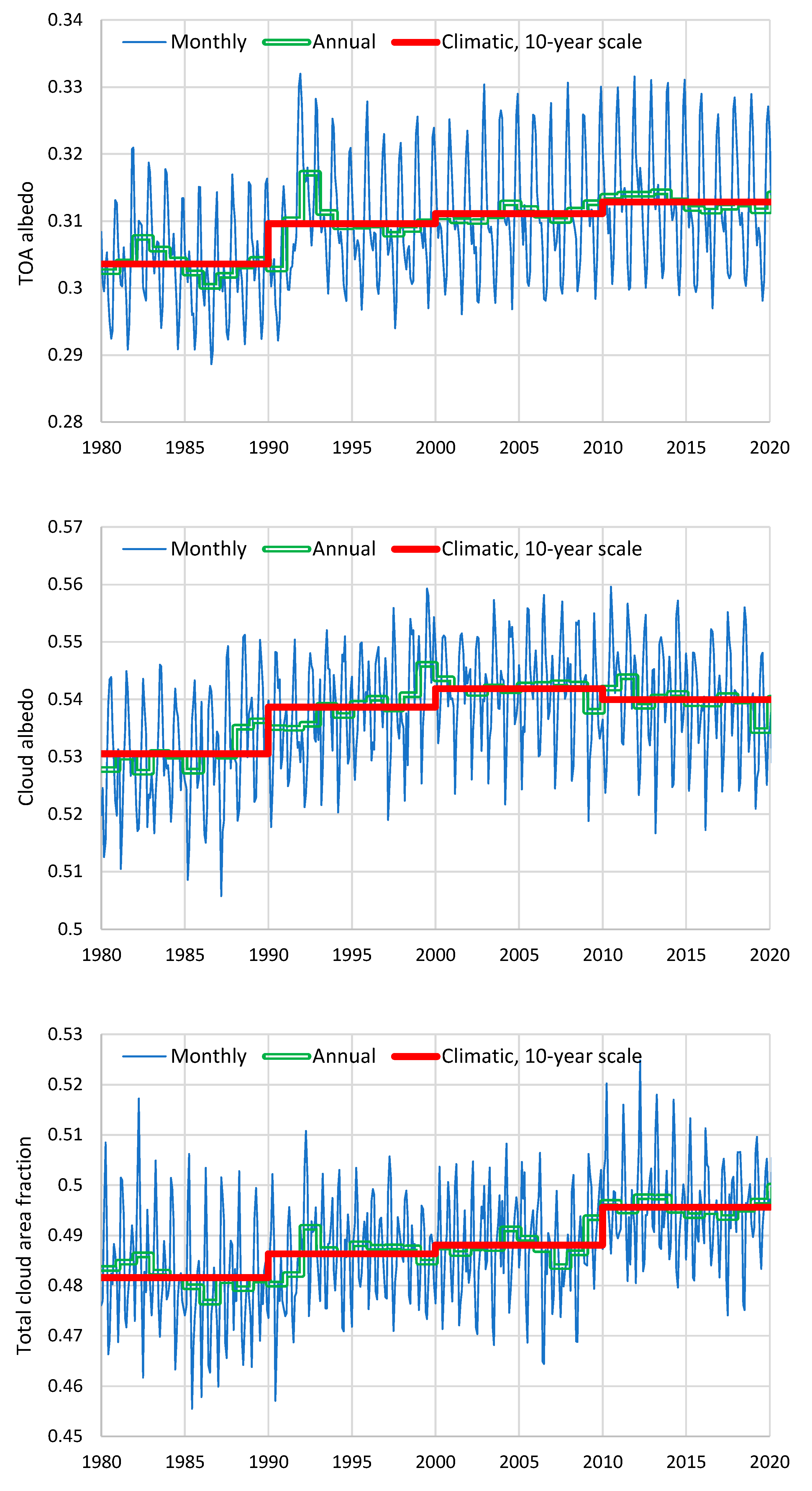
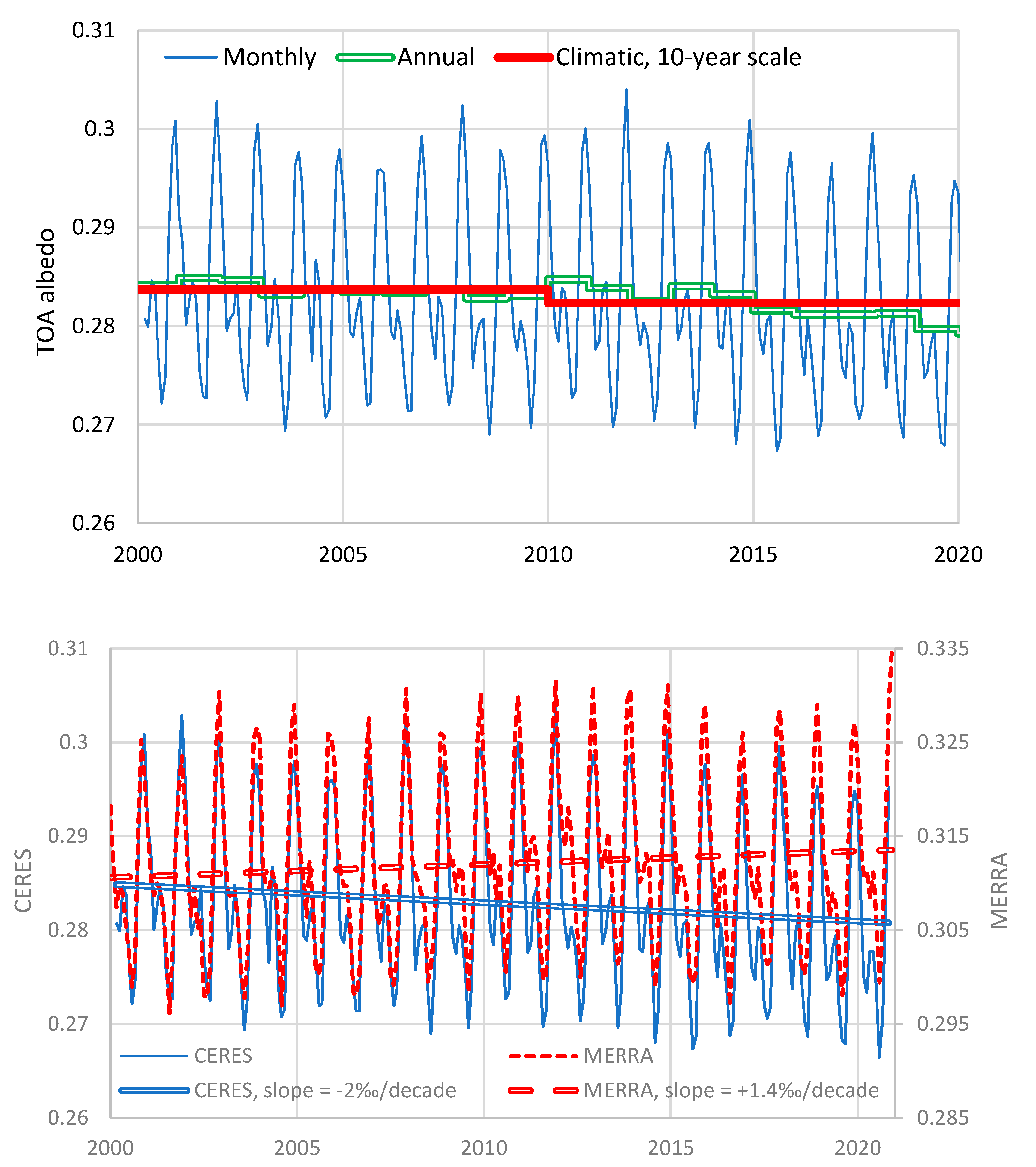
References
- Graham, L.; Kantor, J.-M. Naming Infinity: A True Story of Religious Mysticism and Mathematical Creativity; Harvard University Press: London, UK, 2009. [Google Scholar]
- Shcheglov, D. Hipparchus’ table of climata and Ptolemy’s geography. Orbis Terrarum 2007, 9, 159–192. [Google Scholar]
- Visconti, E.Q. Planches de l’Iconographie Grecque, De l’Imprimerie de P. Didot l’Ainé, Paris, 58 Plates (Engravings). 1817. Available online: https://archive.org/details/gri_33125010850713/ (accessed on 2 February 2021).
- Google Books Ngram Viewer. Available online: https://books.google.com/ngrams/graph?content=climatology (accessed on 2 February 2021).
- Herbertson, A.J. Outlines of Physiography, an Introduction to the Study of the Earth; Arnold: London, UK, 1907. [Google Scholar]
- The Climate Is What You Expect; The Weather Is What You Get. Available online: https://quoteinvestigator.com/2012/06/24/climate-vs-weather/ (accessed on 2 February 2021).
- Köppen, W. Klassifikation der Klima nach Temperatur, Niederschlag und Jahreslauf. Petermanns Mitt. 1918, 64, 193–203. [Google Scholar]
- Köppen, W. Die Klimate der Erde. Grundriss der Klimakunde; Walter de Gruyter: Berlin, Germany, 1923. [Google Scholar]
- Köppen, W. Grundriss der Klimakunde; Walter de Gruyter: Berlin, Germany, 1931. [Google Scholar]
- Köppen, W. Das geographische System der Klimate. In Handbuch der Klimatologie; Köppen, W., Geiger, R., Eds.; Gebrüder Borntraeger: Berlin, Germany, 1936; pp. 1–44. [Google Scholar]
- Geiger, R.; Pohl, W. Eine neue Wandkarte der Klimagebiete der Erde nach W. Köppens Klassifikation (A New Wall Map of the Climatic Regions of the World According to W. Köppen’s Classification). Erdkunde 1954, 8, 58–61. Available online: https://www.jstor.org/stable/25636021 (accessed on 2 February 2021).
- Stamp, L.D. Major natural regions: Herbertson after fifty years. Geography 1957, 42, 201–216. [Google Scholar]
- Lamb, H.H. Climate: Past, Present, and Future, Vol. 1: Fundamentals and Climate Now; Methuen: London, UK, 1972. [Google Scholar]
- National Weather Service Glossary. Available online: https://w1.weather.gov/glossary/index.php?letter=c (accessed on 2 February 2021).
- Climate Glossary by the Climate Prediction Center of the National Weather Service. Available online: https://www.cpc.ncep.noaa.gov/products/outreach/glossary.shtml#C (accessed on 2 February 2021).
- Glossary of Meteorology by the American Meteorological Society. Available online: http://glossary.ametsoc.org/wiki/Climate (accessed on 2 February 2021).
- Peel, M.C.; Finlayson, B.L.; McMahon, T.A. Updated World Map of the Köppen-Geiger Climate Classification, University of Melbourne. 2016. Available online: https://commons.wikimedia.org/wiki/File:World_K%C3%B6ppen_Classification_(with_authors).svg (accessed on 2 February 2021).
- Peel, M.C.; Finlayson, B.L.; McMahon, T.A. Updated world map of the Köppen-Geiger climate classification. Hydrol. Earth Syst. Sci. 2007, 11, 1633–1644. [Google Scholar] [CrossRef]
- Mellinger, A.D.; Sachs, J.D.; Gallup, J.L. Climate, Water Navigability, and Economic Development; CID Working Paper Series 1999.24; Harvard University: Cambridge, MA, USA, 1999; Available online: https://dash.harvard.edu/handle/1/39403786 (accessed on 2 February 2021).
- Finch, V.C.; Trewartha, G.T. Elements of Geography Physical and Cultural; McGraw-Hill: New York, NY, USA, 1936. [Google Scholar]
- World Meteorological Organization (WMO). International Meteorological Vocabulary; No. 182; WMO: Geneva, Switzerland, 1992; Available online: https://library.wmo.int/doc_num.php?explnum_id=4712 (accessed on 2 February 2021).
- Intergovernmental Panel on Climate Change (IPCC). Climate Change 2013: The Physical Science Basis; Contribution of Working Group I to the Fifth Assessment Report of the Intergovernmental Panel on Climate Change; Stocker, T.F., Qin, G.-K., Plattner, D., Tignor, S.K., Allen, M., Boschung, J., Nauels, A., Xia, Y., Bex, V., Midgley, P.M., Eds.; Cambridge University Press: Cambridge, UK; New York, NY, USA, 2013. [Google Scholar]
- Hoffman, J.I. Biostatistics for Medical and Biomedical Practitioners; Academic Press: London, UK, 2015. [Google Scholar]
- Lamb, H.H. Climate: Past, Present, and Future, Vol. 2: Climatic History and the Future; Methuen: London, UK, 1977. [Google Scholar]
- Koutsoyiannis, D. Hurst-Kolmogorov dynamics and uncertainty. J. Am. Water Resour. Assoc. 2011, 47, 481–495. [Google Scholar] [CrossRef]
- Milly, P.C.D.; Betancourt, J.; Falkenmark, M.; Hirsch, R.M.; Kundzewicz, Z.W.; Lettenmaier, D.P.; Stouffer, R.J. Station-arity is dead: Whither water management? Science 2008, 319, 20. [Google Scholar] [CrossRef] [PubMed]
- Koutsoyiannis, D.; Montanari, A. Negligent killing of scientific concepts: The stationarity case. Hydrol. Sci. J. 2015, 60, 1174–1183. [Google Scholar] [CrossRef]
- Montanari, A.; Koutsoyiannis, D. Modeling and mitigating natural hazards: Stationarity is immortal! Water Resour. Res. 2014, 50, 9748–9756. [Google Scholar] [CrossRef]
- Mandelbrot, B.B. Multifractals and 1/ƒ Noise: Wild Self-Affinity in Physics; Springer: Berlin, Germany, 1999. [Google Scholar]
- Koutsoyiannis, D. Stochastics of Hydroclimatic Extremes—A Cool Look at Risk, 330 pages, Edition 0, National Technical Universi-ty of Athens, Athens. 2020. Available online: http://www.itia.ntua.gr/en/docinfo/2000/ (accessed on 2 February 2021).
- GHCN Version 3. Available online: https://climexp.knmi.nl/gdcnprcp.cgi?WMO=ITE00100550 (accessed on 17 February 2019).
- Dext3r of ARPA Emilia Romagna, Rete di monitoraggio RIRER. Available online: http://www.smr.arpa.emr.it/dext3r/ (accessed on 17 February 2019).
- Koutsoyiannis, D. Hydrology and Change. Hydrol. Sci. J. 2013, 58, 1177–1197. [Google Scholar] [CrossRef]
- Koutsoyiannis, D. A random walk on water. Hydrol. Earth Syst Sci. 2010, 14, 585–601. [Google Scholar] [CrossRef]
- Kolmogorov, A.N. Wienersche Spiralen und einige andere interessante Kurven im Hilbertschen Raum. Dokl. Akad. Nauk SSSR 1940, 26, 115–118. [Google Scholar]
- Kolmogorov, A.N. Wiener spirals and some other interesting curves in a Hilbert space. In Selected Works of A. N. Kolmogorov—Vol. 1, Mathematics and Mechanics; Tikhomirov, V.M., Ed.; Kluwer: Dordrecht, The Netherlands, 1991; pp. 303–307. [Google Scholar]
- Hurst, H.E. Long term storage capacities of reservoirs. Trans. Am. Soc. Civil Eng. 1951, 116, 776–808. [Google Scholar]
- Koutsoyiannis, D. Entropy production in stochastics. Entropy 2017, 19, 581. [Google Scholar] [CrossRef]
- Courtillot, V.; Gallet, Y.; Le Mouël, J.L.; Fluteau, F.; Genevey, A. Are there connections between the Earth’s magnetic field and climate? Earth Planet. Sci. Lett. 2007, 253, 328–339. [Google Scholar] [CrossRef]
- Yamaguchi, Y.T.; Yokoyama, Y.; Miyahara, H.; Sho, K.; Nakatsuka, T. Synchronized Northern Hemisphere climate change and solar magnetic cycles during the Maunder Minimum. Proc. Natl. Acad. Sci. USA 2010, 107, 20697–20702. [Google Scholar] [CrossRef]
- Shaviv, N.J.; Veizer, J. Celestial driver of Phanerozoic climate? Geol. Soc. Am. Today 2003, 13, 4–10. [Google Scholar] [CrossRef]
- Shaviv, N.J. On climate response to changes in the cosmic ray flux and radiative budget. J. Geophys. Res. Space Phys. 2005, 110, A08105. [Google Scholar] [CrossRef]
- Milanković, M. Nebeska Mehanika; University of Belgrade: Belgrade, Serbia, 1935; Available online: http://legati.matf.bg.ac.rs/milankovic/book.wafl?book=nebeska_mehanika (accessed on 2 March 2021).
- Milanković, M. Kanon der Erdbestrahlung und seine Anwendung auf das Eiszeitenproblem; Koniglich Serbische Akademice: Beograd, Serbia, 1941. [Google Scholar]
- Milanković, M. Canon of Insolation and the Ice-Age Problem; Agency for Textbooks: Belgrade, Serbia, 1998. [Google Scholar]
- Roe, G. In defense of Milankovitch. Geophys. Res. Lett. 2006, 33. [Google Scholar] [CrossRef]
- Kuhn, W.R.; Walker, J.C.G.; Marshall, H.G. The effect on Earth’s surface temperature from variations in rotation rate, conti-nent formation, solar luminosity, and carbon dioxide. J. Geophys. Res. Atmos. 1989, 94, 11129–11136. [Google Scholar] [CrossRef]
- Koutsoyiannis, D. Climate of the Past and Present, and Its Hydrological Relevance, School for Young Scientists “Modelling and Forecasting of River Flows and Managing Hydrological Risks: Towards a New Generation of Methods”; Russian Academy of Sciences: Moscow, Russia, 2020. [Google Scholar] [CrossRef]
- Koutsoyiannis, D.; Kundzewicz, Z.W. Atmospheric Temperature and CO2: Hen-Or-Egg Causality? Sci 2020, 2, 83. [Google Scholar] [CrossRef]
- Feulner, G. The faint young Sun problem. Rev. Geophys. 2012, 50. [Google Scholar] [CrossRef]
- Ekart, D.D.; Cerling, T.E.; Montanez, I.P.; Tabor, N.J. A 400 million year carbon isotope record of pedogenic carbonate: Im-plications for paleoatmospheric carbon dioxide. Am. J. Sci. 1999, 299, 805–827. [Google Scholar] [CrossRef]
- Augustin, L.; Barbante, C.; Barnes, P.R.; Barnola, J.M.; Bigler, M.; Castellano, E.; Cattani, O.; Chappellaz, J.; Dahl-Jensen, D.; Delmonte, B.; et al. Eight glacial cycles from an Antarctic ice core. Nature 2004, 429, 623–628. [Google Scholar] [CrossRef]
- Higgins, J.A.; Kurbatov, A.V.; Spaulding, N.E.; Brook, E.; Introne, D.S.; Chimiak, L.M.; Yan, Y.; Mayewski, P.A.; Bender, M.L. Atmospheric composition 1 million years ago. Proc. Natl. Acad. Sci. USA 2015, 112, 6887–6891. [Google Scholar] [CrossRef] [PubMed]
- Davis, W.J. The relationship between atmospheric carbon dioxide concentration and global temperature for the last 425 million years. Climate 2017, 5, 76. [Google Scholar] [CrossRef]
- Foster, G.L.; Royer, D.L.; Lunt, D.J. Future climate forcing potentially without precedent in the last 420 million years. Nat. Commun. 2017, 8, 14845. [Google Scholar] [CrossRef] [PubMed]
- Brook, E.J.; Buizert, C. Antarctic and global climate history viewed from ice cores. Nature 2018, 558, 200–208. [Google Scholar] [CrossRef] [PubMed]
- Cui, Y.; Schubert, B.A.; Jahren, A.H. A 23 m.y. record of low atmospheric CO2. Geology 2020, 48, 888–892. [Google Scholar] [CrossRef]
- Koutsoyiannis, D.; Montanari, A.; Lins, H.F.; Cohn, T.A. Climate, hydrology and freshwater: Towards an interactive incor-poration of hydrological experience into climate research—DISCUSSION of “The implications of projected climate change for freshwater resources and their management”. Hydrol. Sci. J. 2009, 54, 394–405. [Google Scholar] [CrossRef]
- Koutsoyiannis, D. Revisiting the global hydrological cycle: Is it intensifying? Hydrol. Earth Syst. Sci. 2020, 24, 3899–3932. [Google Scholar] [CrossRef]
- Poyet, P. The Rational Climate e-Book: Cooler Is Riskier, The Sorry State of Climate Science and Policies; 2021; 450p; ISBN 978-99957-1-929-6; Available online: https://www.researchgate.net/publication/347150306 (accessed on 2 March 2021).
- Koutsoyiannis, D.; Xanthopoulos, T. Engineering Hydrology, 3rd ed.; National Technical University of Athens: Athens, Greece, 1999; 418p. (In Greek) [Google Scholar] [CrossRef]
- Trenberth, K.E.; Guillemot, C.J. The total mass of the atmosphere. J. Geophys. Res. 1994, 99. [Google Scholar] [CrossRef]
- Koutsoyiannis, D. Lecture Notes on Hydrometeorology—Part 1, 2nd ed.; National Technical University of Athens: Athens, Greece, 2000; 157p, Available online: http://www.itia.ntua.gr/116/ (accessed on 2 February 2021).
- Eagleson, P.S. The role of water in climate. Proc. Am. Philos. Soc. 2000, 144, 33–38. [Google Scholar]
- Koutsoyiannis, D. Clausius-Clapeyron equation and saturation vapour pressure: Simple theory reconciled with practice. Eur. J. Phys. 2012, 33, 295–305. [Google Scholar] [CrossRef]
- Cogley, J.G. The albedo of water as a function of latitude. Mon. Weather Rev. 1979, 107, 775–781. [Google Scholar] [CrossRef]
- Han, Q.; Rossow, W.B.; Chou, J.; Welch, R.M. Global survey of the relationships of cloud albedo and liquid water path with droplet size using ISCCP. J. Clim. 1998, 11, 1516–1528. [Google Scholar] [CrossRef]
- Trenberth, K.E.; Fasullo, J.T.; Kiehl, J. Earth’s global energy budget, B. Am. Meteorol. Soc. 2009, 90, 311–324. [Google Scholar] [CrossRef]
- Schmidt, G.A.; Ruedy, R.A.; Miller, R.L.; Lacis, A.A. Attribution of the present-day total greenhouse effect. J. Geophys. Res. 2010, 115, D20106. [Google Scholar] [CrossRef]
- Weiss, R. Carbon dioxide in water and seawater: The solubility of a non-ideal gas. Mar. Chem. 1974, 2, 203–215. [Google Scholar] [CrossRef]
- Screen, J.A.; Bracegirdle, T.J.; Simmonds, I. Polar climate change as manifest in atmospheric circulation. Curr. Clim. Chang. Rep. 2018, 4, 383–395. [Google Scholar] [CrossRef]
- Lee, S.; Gong, T.; Feldstein, S.B.; Screen, J.A.; Simmonds, I. Revisiting the cause of the 1989-2009 Arctic surface warming us-ing the surface energy budget: Downward infrared radiation dominates the surface fluxes. Geophys. Res. Lett. 2017, 44, 10, 654–661. [Google Scholar] [CrossRef]
- Luo, B.; Luo, D.; Wu, L.; Zhong, L.; Simmonds, I. Atmospheric circulation patterns which promote winter Arctic sea ice decline. Environ. Res. Lett. 2017, 12, 054017. [Google Scholar] [CrossRef]
- Kundzewicz, Z.W.; Pinskwar, I.; Koutsoyiannis, D. Variability of global mean annual temperature is significantly influ-enced by the rhythm of ocean-atmosphere oscillations. Sci. Total Environ. 2020, 747, 141256. [Google Scholar] [CrossRef]
- Allen, H.R. The American Farm and Home Cyclopedia; W. H. Thompson: Philadelphia, PA, USA, 1883. [Google Scholar]
- Eagleson, P.S. Global change, a catalyst for the development of hydrologic science. Bull. Am. Meteorol. Soc. 1991, 72, 34–43. [Google Scholar] [CrossRef]
- Crutzen, P.J.; Stoermer, E.F. The “Anthropocene”. Glob. Chang. Newsl. 2000, 41, 16–18. Available online: http://www.igbp.net/download/18.316f18321323470177580001401/1376383088452/NL41.pdf (accessed on 2 March 2021).
- Buschmann, D. What is critical in the Anthropocene? A discussion of four conceptual problems from the environmen-tal-political philosophy perspective. Ethics Bioethics Cent. Eur. 2021, 10, 190–202. [Google Scholar] [CrossRef]
- Sagoff, M. Welcome to the Narcisscene. Breakthr. J 2018, 9. Available online: https://thebreakthrough.org/journal/no-9-summer-2018/welcome-to-the-narcisscene (accessed on 2 March 2021).
- Koutsoyiannis, D.; Efstratiadis, A.; Mamassis, N.; Christofides, A. On the credibility of climate predictions. Hydrol. Sci. J. 2008, 53, 671–684. [Google Scholar] [CrossRef]
- Tsaknias, D.; Bouziotas, D.; Koutsoyiannis, D. Statistical comparison of observed temperature and rainfall extremes with climate model outputs in the Mediterranean region. ResearchGate 2016. [Google Scholar] [CrossRef]
- Anagnostopoulos, G.G.; Koutsoyiannis, D.; Christofides, A.; Efstratiadis, A.; Mamassis, N. A comparison of local and ag-gregated climate model outputs with observed data. Hydrol. Sci. J. 2010, 55, 1094–1110. [Google Scholar] [CrossRef]
- Koutsoyiannis, D.; Christofides, A.; Efstratiadis, A.; Anagnostopoulos, G.G.; Mamassis, N. Scientific dialogue on climate: Is it giving black eyes or opening closed eyes? Reply to “A black eye for the Hydrol. Sci. J.” by D. Huard. Hydrol. Sci. J. 2011, 56, 1334–1339. [Google Scholar] [CrossRef]
- Tyralis, H.; Koutsoyiannis, D. On the prediction of persistent processes using the output of deterministic models. Hydrol. Sci. J. 2017, 62, 2083–2102. [Google Scholar] [CrossRef]
- Kolmogorov, A.N. Über die analytischen Methoden in der Wahrscheinlichkeitsrechnung. Math. Ann. 1931, 104, 415–458. [Google Scholar] [CrossRef]
- Kolmogorov, A.N. On analytical methods in probability theory, In Selected Works of A. N. Kolmogorov—Volume 2, Probability Theory and Mathematical Statistics; Shiryayev, A.N., Ed.; Kluwer: Dordrecht, The Netherlands, 1992; pp. 62–108. [Google Scholar]
- Koutsoyiannis, D. Rebuttal to review comments on “Revisiting global hydrological cycle: Is it intensifying?” (Interactive comment on “Revisiting global hydrological cycle: Is it intensifying?” by Demetris Koutsoyiannis). Hydrol. Earth Syst. Sci. Discuss. 2020. Available online: https://www.hydrol-earth-syst-sci-discuss.net/hess-2020-120/hess-2020-120-AC1-supplement.pdf (accessed on 2 March 2021). [CrossRef]
- Koutsoyiannis, D. Vít Klemeš (1932–2010). 2011. Available online: https://motls.blogspot.com/2011/03/vit-klemes-1932-2010.html (accessed on 2 February 2021).
- CIA (Central Intelligence Agency). USSR: The Impact of Recent Climate Change on Grain Production; Report ER 76-10577 U; Washington, DC, USA, 1976; Available online: https://books.google.gr/books?id=fMaRQs4PkBoC (accessed on 2 February 2021).
- Kissinger, H.A. Address to the Sixth Special Session of the United Nations General Assembly. News Release by United States, Department of State Office of Media Services. 1974. Available online: https://books.google.gr/books?id=JDwVh5JK3dMC&pg=RA1-PA1 (accessed on 21 January 2021).
- The Comparative Agendas Project. Available online: https://www.comparativeagendas.net/datasets_codebooks (accessed on 2 February 2021).
- Baler, W. The challenge to agricultural meteorology. WMO Bull. 1974, XXIII, 221–224. Available online: https://library.wmo.int/doc_num.php?explnum_id=6621 (accessed on 2 February 2021).
- Lewin, B. Searching for the Catastrophe Signal: The Origins of the Intergovernmental Panel on Climate Change; Global Warming Policy Foundation: London, UK, 2017. [Google Scholar]
- UN General Assembly. United Nations General Assembly Resolution 43/53: Protection of Global Climate for Present and Future Generations of Mankind. A/RES/43/53. In International Legal Materials; 1988; Volume 28, p. 1326. Available online: https://www.ipcc.ch/site/assets/uploads/2019/02/UNGA43-53.pdf (accessed on 2 February 2021).
- The Rockefeller Foundation. Presidents Review & Annual Report 1974; The Rockefeller Foundation: New York, NY, USA, 1974; Available online: https://www.rockefellerfoundation.org/wp-content/uploads/Annual-Report-1974-1.pdf (accessed on 2 February 2021).
- The Rockefeller Foundation. Presidents Review & Annual Report 1975; The Rockefeller Foundation: New York, NY, USA, 1975; Available online: https://www.rockefellerfoundation.org/wp-content/uploads/Annual-Report-1975-1.pdf (accessed on 2 February 2021).
- Hare, F.K. Changing climate and human response: The impact of recent events on climatology. Geoforum 1984, 15, 383–394. [Google Scholar] [CrossRef]
- Anonymous. Another Ice Age? Time, 24 June 1974. Available online: http://content.time.com/time/magazine/article/0,9171,944914,00.html (accessed on 2 February 2021).
- Anonymous. Environment: The World’s Climate: Unpredictable. Time, 9 August 1976. Available online: http://content.time.com/time/subscriber/article/0,33009,914494,00.html (accessed on 2 February 2021).
- Lemonick, M.D. The Heat Is On—Chemical Wastes Spewed into the Air Threaten the Earth’s Climate. Time, 19 October 1987. Available online: http://content.time.com/time/magazine/article/0,9171,965776,00.html (accessed on 2 February 2021).
- Sancton, T.H. Planet of the Year: What on Earth Are We Doing? Time, 2 January 1989. Available online: http://content.time.com/time/subscriber/printout/0,8816,956627,00.html (accessed on 2 February 2021).
- Time, 1 June 1992 Cover. Available online: http://content.time.com/time/covers/0,16641,19920601,00.html (accessed on 2 February 2021).
- Schwab, K.; Malleret, T. The Great Reset; World Economic Forum: Geneva, Switzerland, 2020. [Google Scholar]
- Harari, Y.N. Sapiens: A Brief History of Humankind; Random House: New York, NY, USA, 2014; Available online: https://books.google.gr/books?id=FmyBAwAAQBAJ (accessed on 2 February 2021).
- US National Intelligence Council. Global Governance 2025: At a Critical Juncture. 2010. Available online: https://www.dni.gov/files/documents/Global%20Trends_2025%20Global%20Governance.pdf (accessed on 2 February 2021).
- EU Institute for Security Studies. Global Governance 2025: At a Critical Juncture. 2010. Available online: https://www.iss.europa.eu/content/global-governance-2025-critical-juncture (accessed on 2 February 2021).
- Rockefeller Brothers Fund. Change—Global Warming, 2005 Annual Report. 2005. Available online: https://www.rbf.org/sites/default/files/2005_Annual_Review.pdf (accessed on 2 February 2021).
- Neumann, J.; Flohn, H. Great historical events that were significantly affected by the weather: Part 8, Germany’s war on the Soviet Union, 1941–45. I. Long-range weather forecasts for 1941–42 and climatological studies. Bull. Am. Meteorol. Soc. 1987, 68, 620–630. [Google Scholar] [CrossRef][Green Version]
- Koutsoyiannis, D. Climate change impacts on hydrological science: How the climate change agenda has lowered the scien-tific level of hydrology (Plenary talk). In Proceedings of the 13th International Conference on Hydroinformatics (HIC 2018), Palermo, Italy, 1–5 July 2018. [Google Scholar] [CrossRef]
- Peixoto, J.P.; Oort, A.H. Physics of Climate; American Institute of Physics: College Park, MD, USA, 1992; 520p. [Google Scholar]
- Taylor, A.E.; Aristotle, T.C.; Jack, E.C. London. 1919. Available online: http://www.gutenberg.org/files/48002/48002-h/48002-h.html (accessed on 2 February 2021).
- Horrigan, P.G. Epistemology: An Introduction to the Philosophy of Knowledge; iUniverse: New York, NY, USA, 2007; Available online: http://books.google.gr/books?id=ZcF76pdhha8C (accessed on 2 February 2021).
- Papastephanou, M. The ‘lifeblood’of science and its politics: Interrogating epistemic curiosity as an educational aim. Educ. Sci. 2015, 6, 1–16. [Google Scholar] [CrossRef]
- Koutsoyiannis, D.; Mamassis, N. From mythology to science: The development of scientific hydrological concepts in the Greek antiquity and its relevance to modern hydrology. Hydrol. Earth Syst. Sci. Discuss. 2021. [Google Scholar] [CrossRef]
- Wagner, J.C. Atmosphaera Sublunaris, Koppmayer, Noriberg (Nuremberg). 1682. Available online: https://www.europeana.eu/en/item/368/item_RP72IKUOHHZU7ZZU7J3GTM3DP4SMMM3B (accessed on 2 February 2021).
- Fritts, H. Tree Rings and Climate; Academic Press: New York, NY, USA, 1976. [Google Scholar]
- Von Storch, H.; Zwiers, F.W. Statistical Analysis in Climate Research; Cambridge University Press: Cambridge, UK, 2004. [Google Scholar]
- Geiger, R.; Aron, R.H.; Todhunter, P. The Climate Near the Ground; Rowman & Littlefield: Lanham, MD, USA, 2009. [Google Scholar]
- Linacre, E. Climate Data and Resources: A Reference and Guide; Routledge: London, UK, 1992. [Google Scholar]
- Oke, T.R. Boundary Layer Climates, 2nd ed.; Routledge: London, UK, 1987. [Google Scholar]
- Wallace, J.W.; Hobbs, P.V. Atmospheric Science, An Introductory Survey; Academic Press: San Diego, CA, USA, 1977. [Google Scholar]
- Andrews, D.G. An Introduction to Atmospheric Physics; Cambridge University Press: Cambridge, UK, 2000. [Google Scholar]
- Ahrens, C.D. Essentials of Meteorology: An Invitation to the Atmosphere, 6th ed.; Brooks/Cole: Belmont, CA, USA, 2010. [Google Scholar]
- Glynis, K.-G.; Iliopoulou, T.; Dimitriadis, P.; Koutsoyiannis, D. Stochastic investigation of daily air temperature extremes from a global ground station network. Stoch. Environ. Res. Risk Assess. 2021, in press. [Google Scholar]
- Cheng, L.; Abraham, J.; Trenberth, K.E.; Fasullo, J.; Boyer, T.; Locarnini, R.; Zhang, B.; Yu, F.; Wan, L.; Chen, X.; et al. Up-per Ocean Temperatures Hit Record High in 2020. Adv. Atmos. Sci. 2021. [Google Scholar] [CrossRef]
- Measuring Earth’s Albedo by NASA. Available online: https://earthobservatory.nasa.gov/images/84499/measuring-earths-albedo?src=ve (accessed on 26 February 2021).
- Zhan, C.; Allan, R.P.; Liang, S.; Wang, D.; Song, Z. Evaluation of five satellite top-of-atmosphere albedo products over land. Remote Sens. 2019, 11, 2919. [Google Scholar] [CrossRef]
- Loeb, N.G.; Wielicki, B.A. Earth’s radiation budget. In Encyclopedia of Atmospheric Sciences; North, G.R., Pyle, J.A., Zhang, F., Eds.; Elsevier: Amsterdam, The Netherlands, 2014; Volume 5, pp. 67–76. Available online: https://books.google.gr/books?id=8lpzAwAAQBAJ&pg=RA4-PA72 (accessed on 26 February 2021).
- Giovanni. The Bridge Between Data and Science, v 4.34. Available online: https://giovanni.gsfc.nasa.gov/ (accessed on 26 February 2021).
- Global Modeling and Assimilation Office (GMAO). MERRA-2 tavgM_2d_csp_Nx: 2d, Monthly mean, Time-averaged, Single-Level, Assimilation, COSP Satellite Simulator V5.12.4; Goddard Earth Sciences Data and Information Services Center (GES DISC): Greenbelt, MD, USA, 2015.
- CERES Data Products. SSF1deg—Level 3, Gridded Daily and Monthly Averages of the SSF Product by Instrument. Available online: https://ceres-tool.larc.nasa.gov/ord-tool/jsp/SSF1degEd41Selection.jsp (accessed on 2 March 2021).

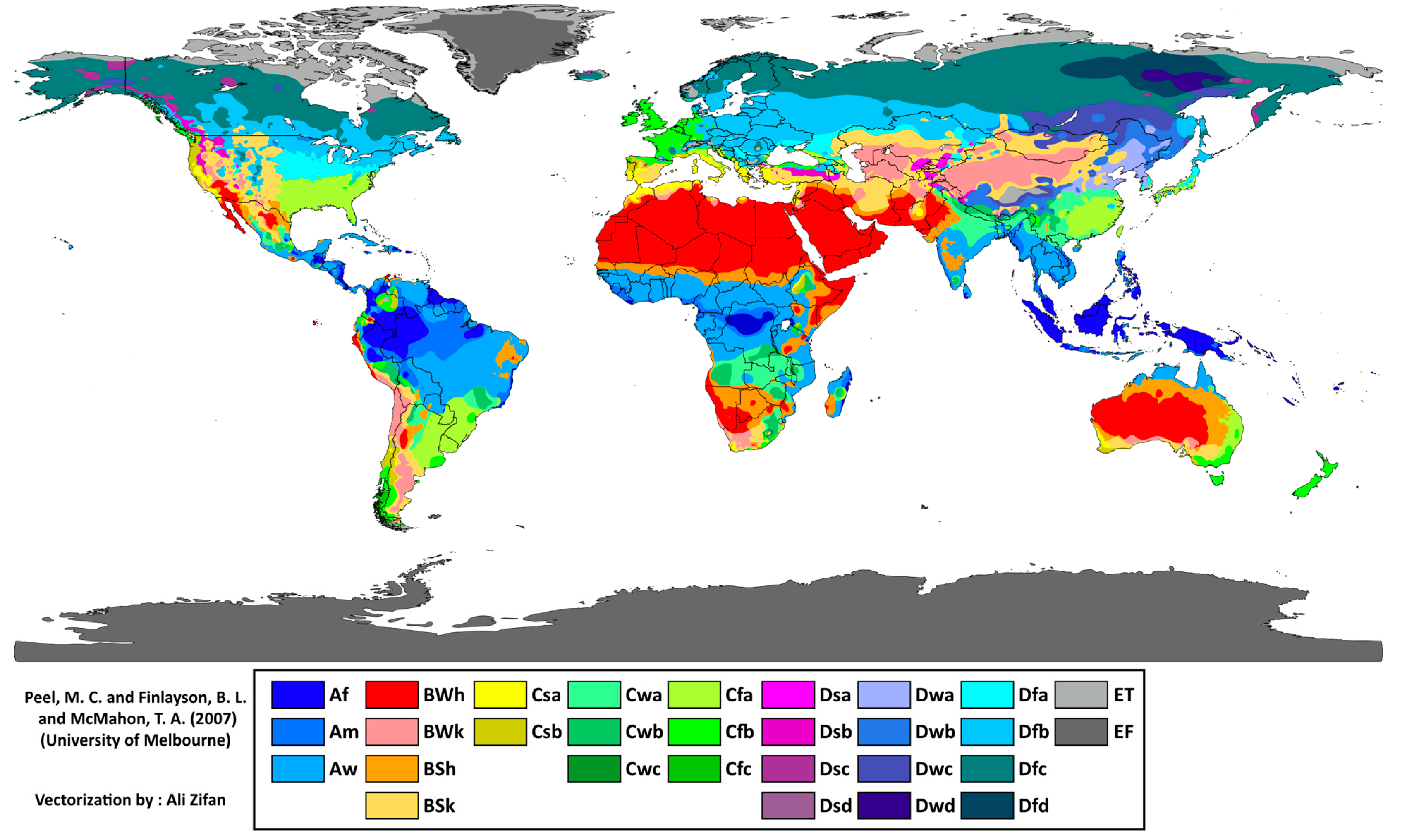
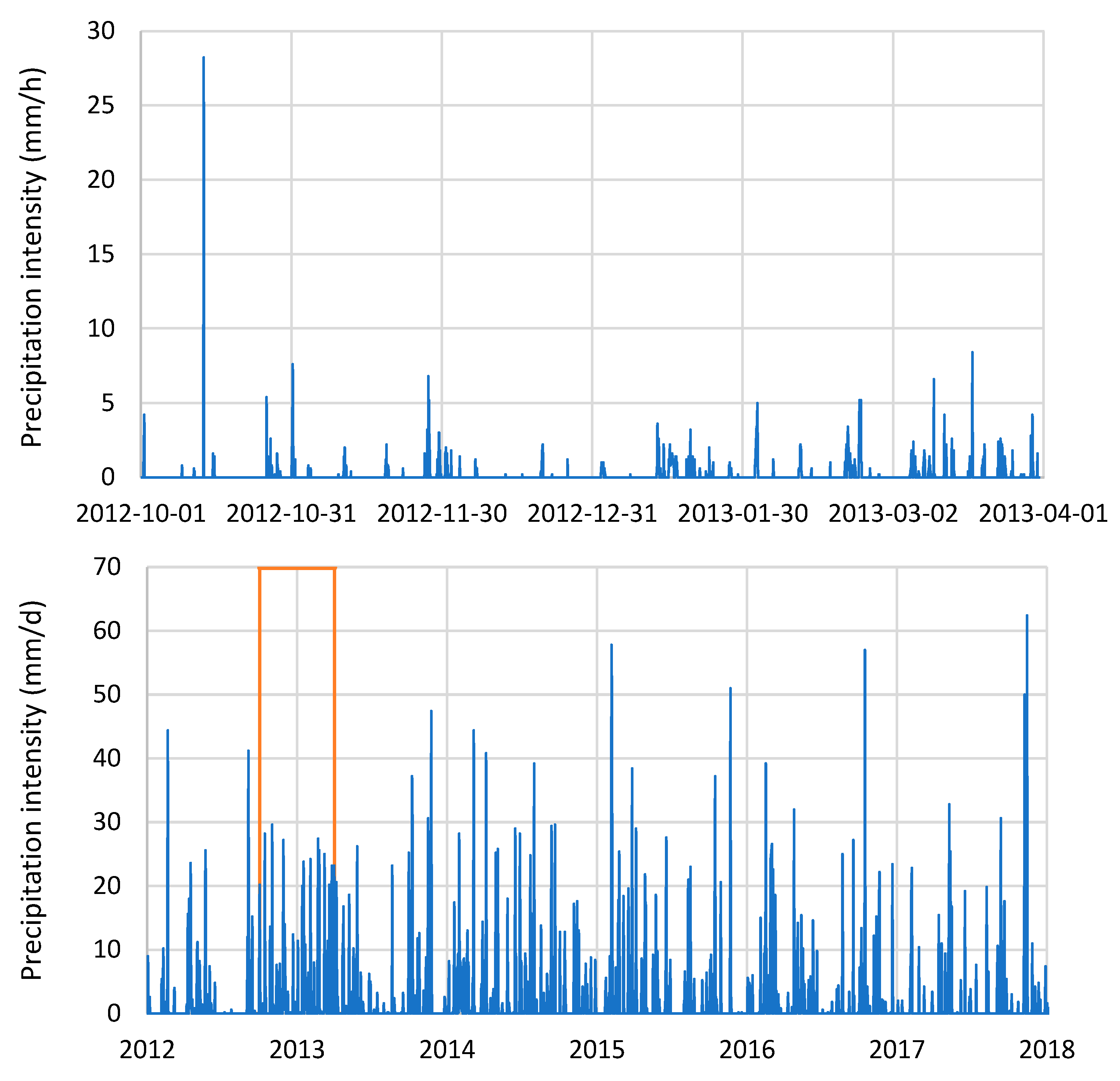
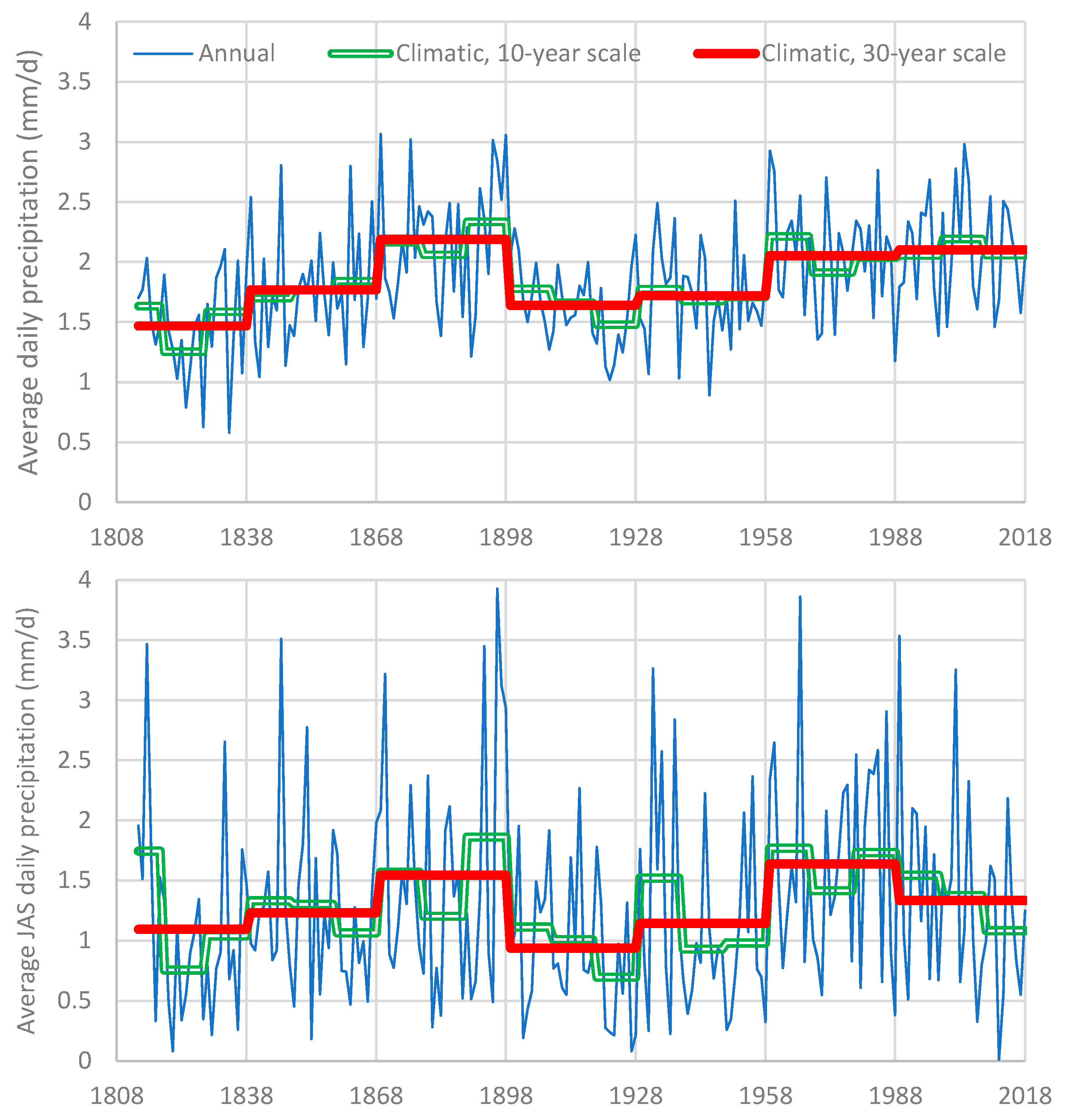
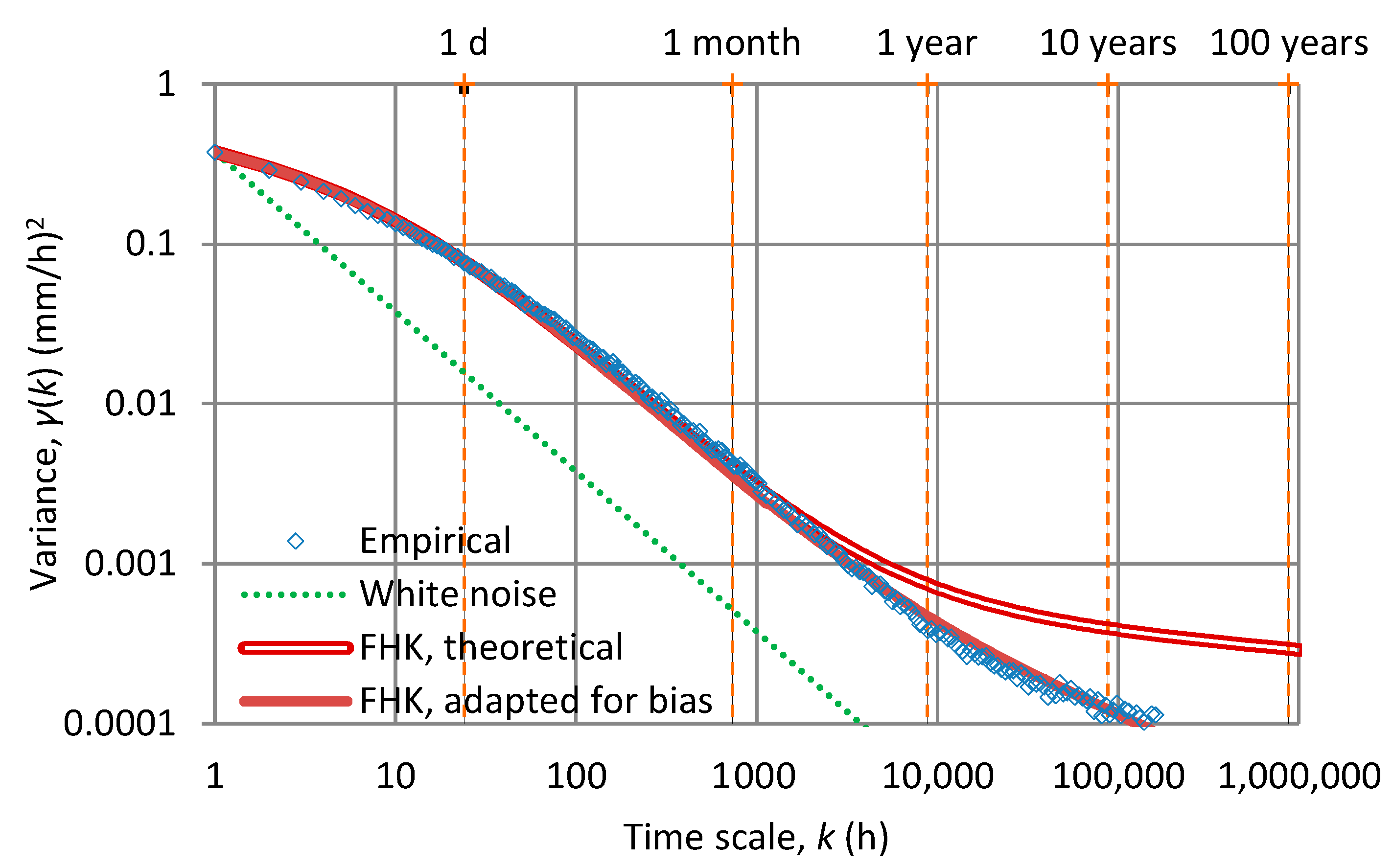
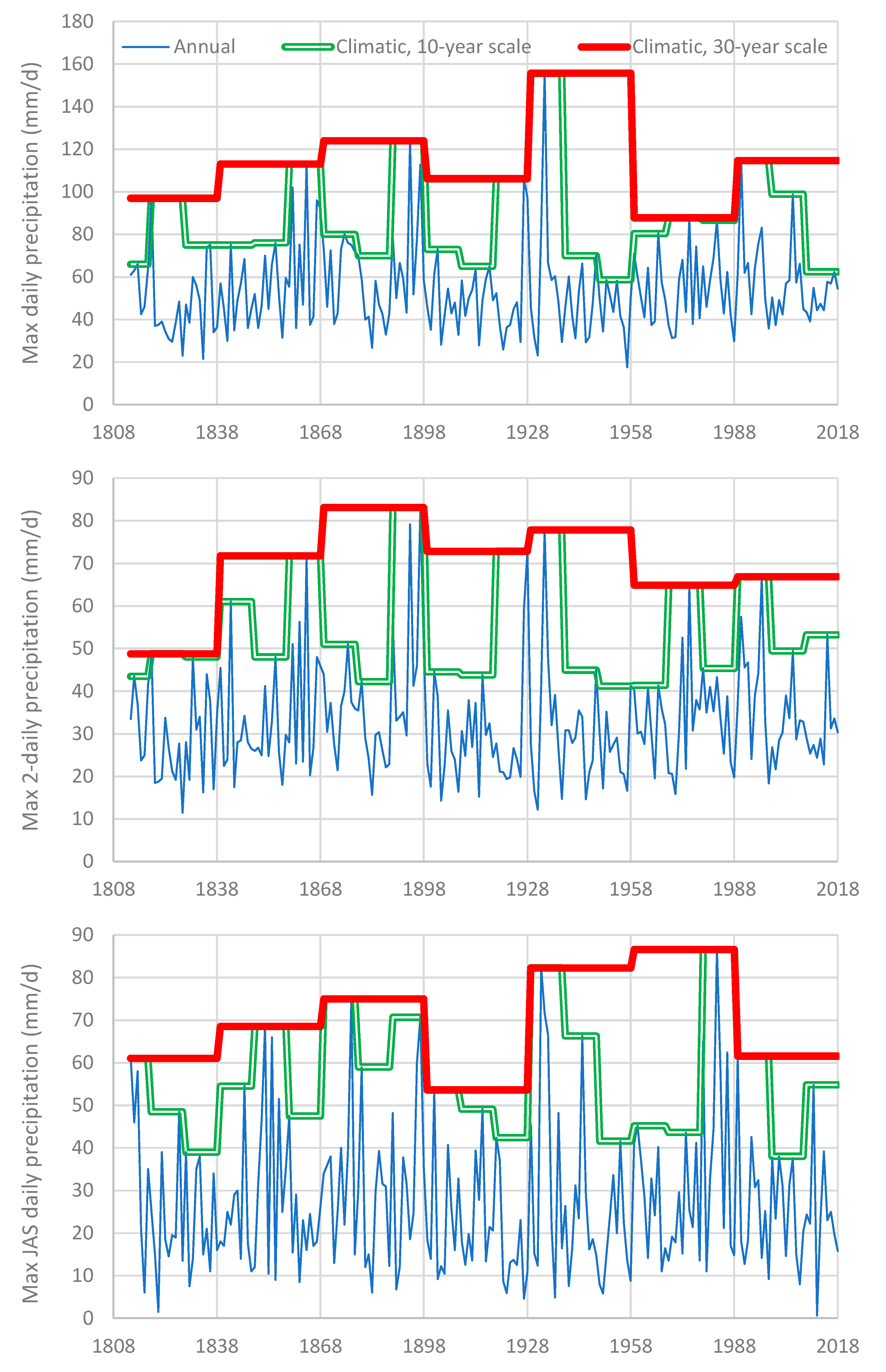
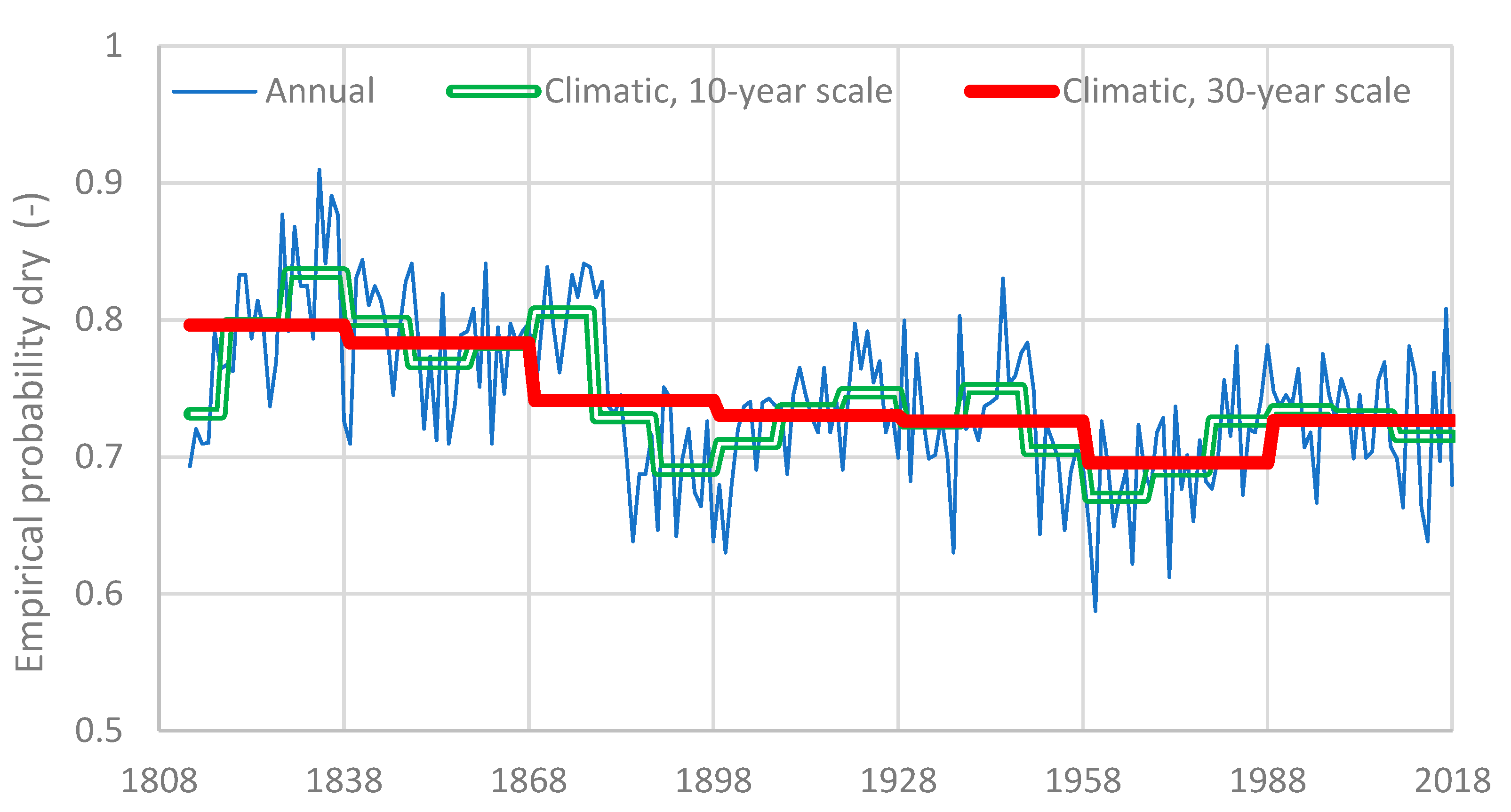
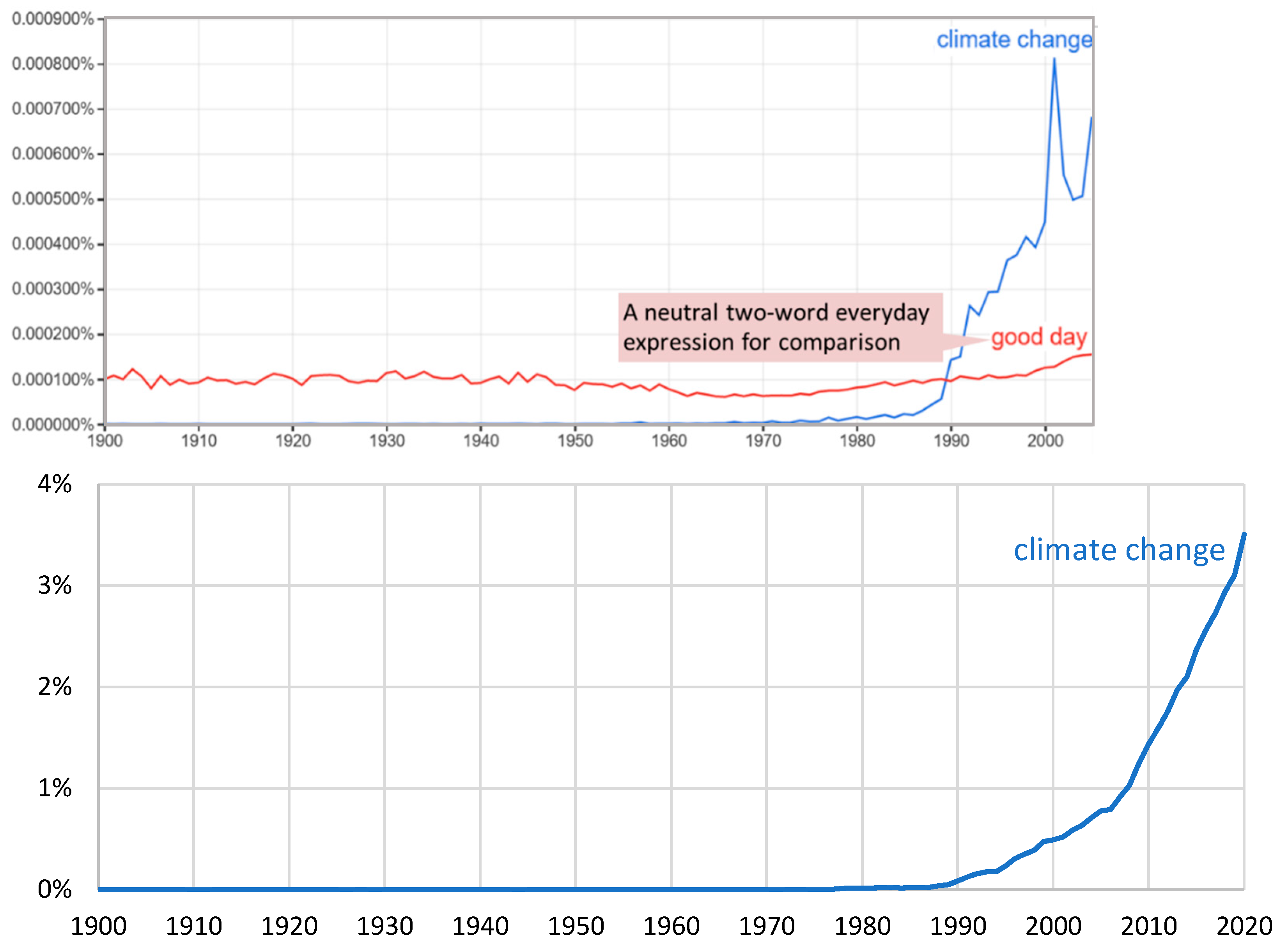
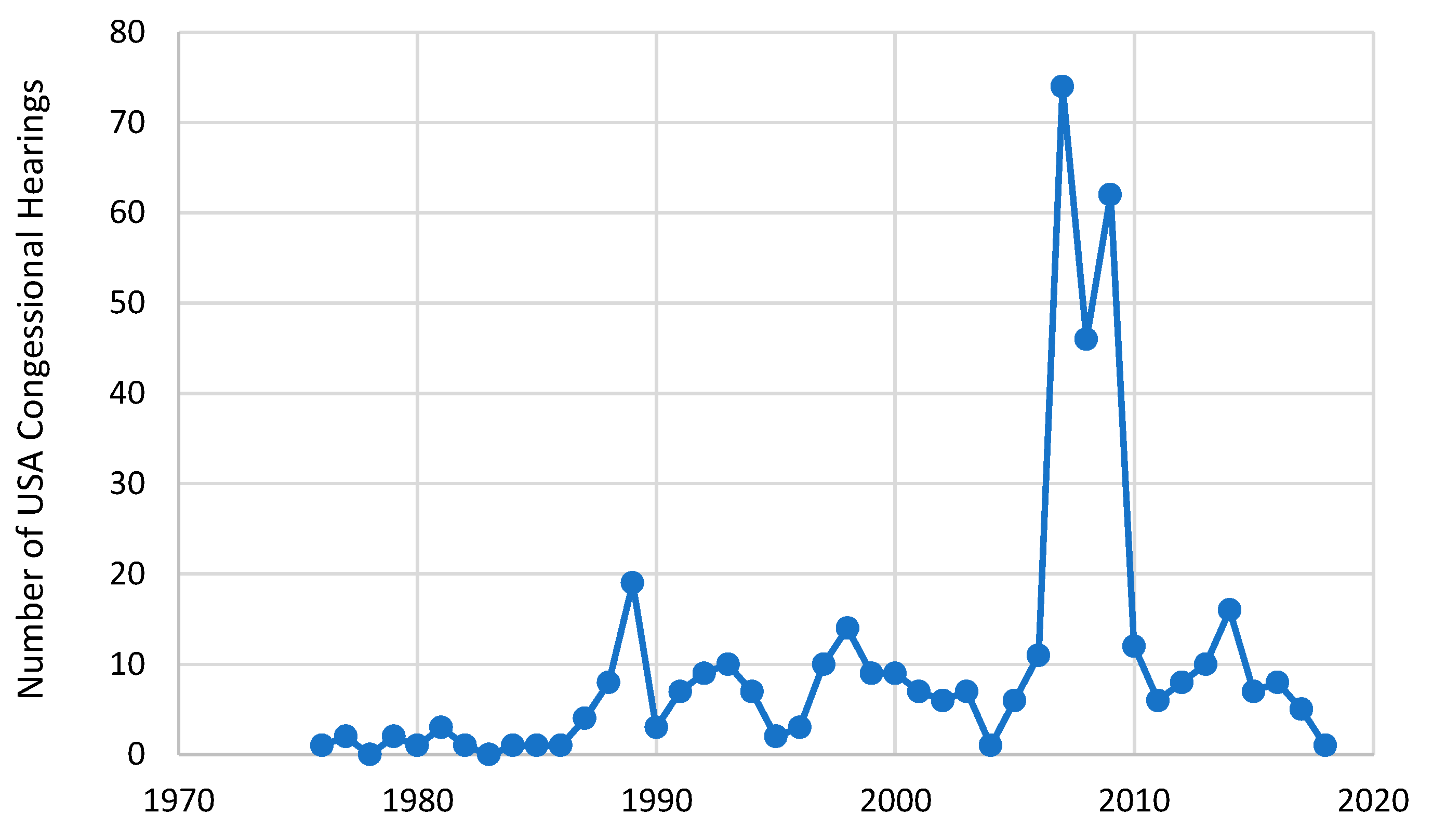
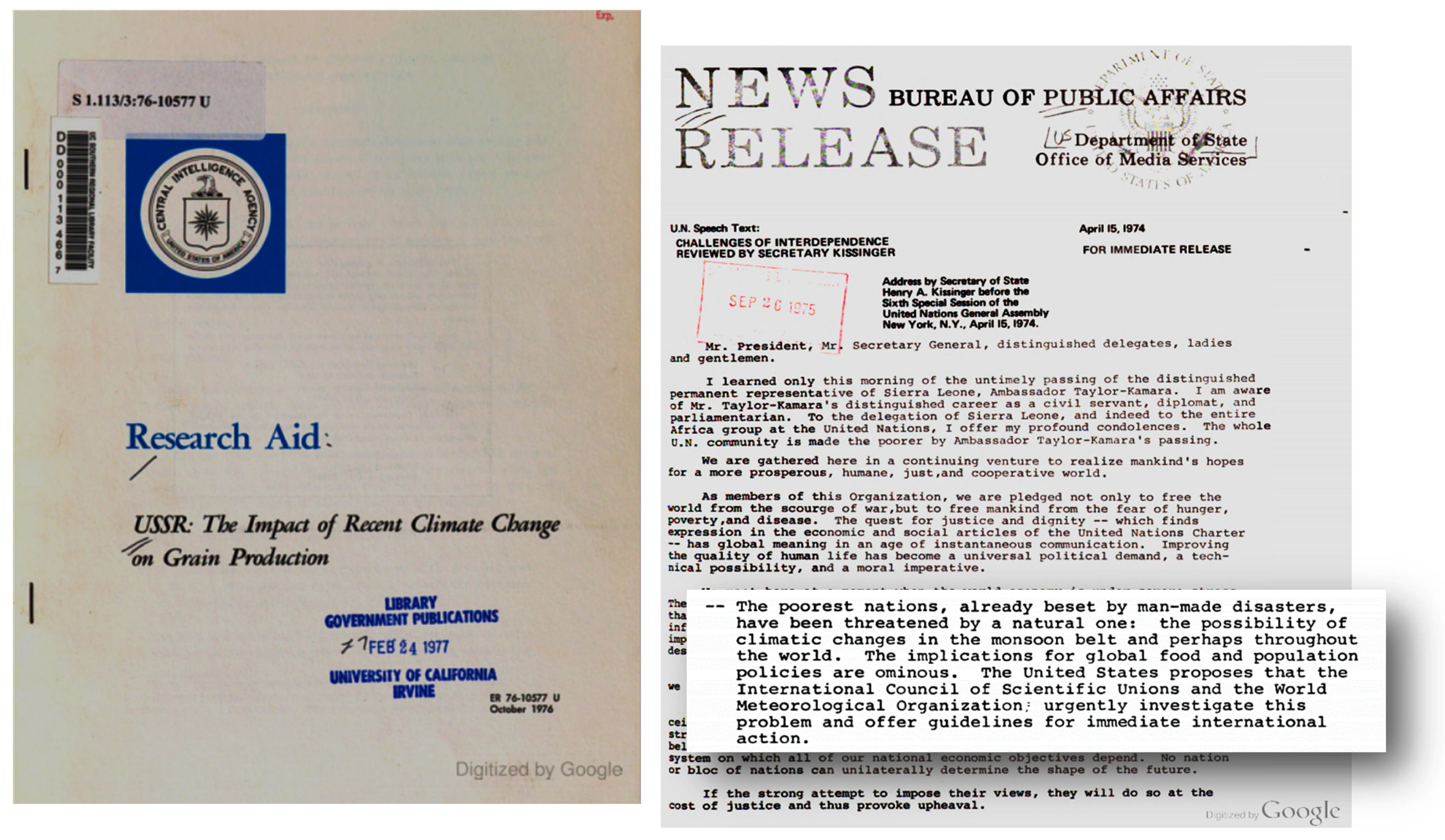
| Symbol | Description of Climate Type | % Area | % Population | % GDP |
|---|---|---|---|---|
| Af | Tropical rainforest | 4.0 | 4.4 | 2.8 |
| Am | Tropical monsoon | 0.8 | 2.4 | 1.0 |
| Aw | Tropical savanna | 10.8 | 17.5 | 6.6 |
| BW | Arid, desert | 17.3 | 6.2 | 3.6 |
| BS | Semi-arid (steppe) | 12.3 | 11.8 | 6.5 |
| Cs | Temperate with a dry summer | 2.2 | 4.3 | 9.1 |
| Cf | Temperate without a dry season | 7.7 | 19.5 | 43.7 |
| Cw | Temperate with a dry winter | 4.3 | 16.0 | 7.0 |
| Df | Continental without a dry season | 22.9 | 5.8 | 11.0 |
| Dw | Continental with a dry winter | 6.4 | 5.3 | 3.4 |
| E | Polar | 4.0 | 0.0 | - |
| H | Highland * | 7.3 | 6.8 | 5.3 |
| Total | 100.0 | 100.0 | 100.0 |
| Statistic | 1813–1838 | 1839–1868 | 1869–1898 | 1899–1928 | 1929–1958 | 1959–1988 | 1989–2018 |
|---|---|---|---|---|---|---|---|
| Temperature, annual (°C) | 13.9 | 13.4 | 13.7 | 13.8 | 14.0 | 13.8 | 15.3 |
| Temperature, hot half-year (°C) * | 20.9 | 20.4 | 20.5 | 20.3 | 21.1 | 20.2 | 21.8 |
| Temperature, cold half-year (°C) | 6.8 | 6.3 | 6.8 | 7.3 | 7.0 | 7.3 | 8.7 |
| Temperature, hottest month (°C) | 25.4 | 24.8 | 25.3 | 24.6 | 25.5 | 24.5 | 26.2 |
| Temperature, coldest month (°C) | 1.4 | 1.3 | 1.7 | 2.8 | 2.0 | 2.6 | 4.4 |
| Number of months with temperature >10 °C | 7 | 7 | 7 | 7 | 7 | 7 | 8 |
| Precipitation, annual (mm) | 536.4 | 646.4 | 798.7 | 598.4 | 628.0 | 750.1 | 767.2 |
| Precipitation, hot half-year (mm) | 265.7 | 318.4 | 378.8 | 281.8 | 276.1 | 351.3 | 365.5 |
| Precipitation, cold half-year (mm) | 270.7 | 328.0 | 420.0 | 316.7 | 351.8 | 398.8 | 401.7 |
| Precipitation, driest month of hot half-year * (mm) | 30.2 | 34.0 | 40.9 | 26.0 | 32.9 | 46.5 | 40.1 |
| Precipitation, wettest month of hot half-year (mm) | 62.4 | 74.1 | 84.3 | 62.5 | 66.1 | 65.2 | 76.6 |
| Precipitation, driest month of cold half-year * (mm) | 30.1 | 27.9 | 40.0 | 30.9 | 44.6 | 47.3 | 40.2 |
| Precipitation, wettest month of cold half-year (mm) | 60.7 | 87.4 | 114.2 | 74.9 | 90.3 | 86.7 | 88.4 |
| Köppen climate type | Cfa | Cfa | Cfa | Cfa | Cfa | Cfa | Cfa |
Publisher’s Note: MDPI stays neutral with regard to jurisdictional claims in published maps and institutional affiliations. |
© 2021 by the author. Licensee MDPI, Basel, Switzerland. This article is an open access article distributed under the terms and conditions of the Creative Commons Attribution (CC BY) license (http://creativecommons.org/licenses/by/4.0/).
Share and Cite
Koutsoyiannis, D. Rethinking Climate, Climate Change, and Their Relationship with Water. Water 2021, 13, 849. https://doi.org/10.3390/w13060849
Koutsoyiannis D. Rethinking Climate, Climate Change, and Their Relationship with Water. Water. 2021; 13(6):849. https://doi.org/10.3390/w13060849
Chicago/Turabian StyleKoutsoyiannis, Demetris. 2021. "Rethinking Climate, Climate Change, and Their Relationship with Water" Water 13, no. 6: 849. https://doi.org/10.3390/w13060849
APA StyleKoutsoyiannis, D. (2021). Rethinking Climate, Climate Change, and Their Relationship with Water. Water, 13(6), 849. https://doi.org/10.3390/w13060849






